Dell 5HCKT Notebook Computer w/ Intel PRO/Wireless 2195ABG User Manual book
Dell Inc. Notebook Computer w/ Intel PRO/Wireless 2195ABG book
Dell >
Contents
Users Manual 1
www.dell.com | support.dell.com
Dell™ Portable Computers
Owner’s Manual
Model PP19L
book.book Page 1 Wednesday, September 28, 2005 2:16 PM

Notes, Notices, and Cautions
NOTE: A NOTE indicates important information that helps you make better use of your computer.
NOTICE: A NOTICE indicates either potential damage to hardware or loss of data and tells you how to avoid the
problem.
CAUTION: A CAUTION indicates a potential for property damage, personal injury, or death.
Abbreviations and Acronyms
For a complete list of abbreviations and acronyms, see the "Glossary" on page 163.
If you purchased a Dell™ n Series computer, any references in this document to Microsoft
®
Windows
®
operating systems are not applicable.
____________________
Information in this document is subject to change without notice.
© 2005 Dell Inc. All rights reserved.
Reproduction in any manner whatsoever without the written permission of Dell Inc. is strictly forbidden.
Trademarks used in this text: Dell, the DELL logo, Inspiron, Dell Precision, Dimension, DellNet, OptiPlex, Latitude, PowerEdge, PowerConnect,
PowerVault, PowerApp, Dell TravelLite, ExpressCharge, and Strike Zone are trademarks of Dell Inc.; Intel, Celeron, and Pentium are registered
trademarks of Intel Corporation; Microsoft, Outlook, and Windows are registered trademarks of Microsoft Corporation; Bluetooth is a registered
trademark owned by Bluetooth SIG, Inc. and is used by Dell under license; IBM is a registered trademark of International Business Machines
Corporation; EMC is a registered trademark of EMC Corporation; ENERGY STAR is a registered trademark of the U.S. Environmental Protection
Agency.
Other trademarks and trade names may be used in this document to refer to either the entities claiming the marks and names or their products.
Dell Inc. disclaims any proprietary interest in trademarks and trade names other than its own.
Model PP19L
October 2005 Rev. A01
book.book Page 2 Wednesday, September 28, 2005 2:16 PM

Contents 3
Contents
Finding Information . . . . . . . . . . . . . . . . . . . . . . . . . . . . . . . 11
1 A Tour of Your Computer
Front View . . . . . . . . . . . . . . . . . . . . . . . . . . . . . . . . . . . . 15
Left Side View . . . . . . . . . . . . . . . . . . . . . . . . . . . . . . . . . . 19
Right Side View . . . . . . . . . . . . . . . . . . . . . . . . . . . . . . . . . 21
Back View . . . . . . . . . . . . . . . . . . . . . . . . . . . . . . . . . . . . 22
Bottom View . . . . . . . . . . . . . . . . . . . . . . . . . . . . . . . . . . . 23
2 Setting Up Your Computer
Connecting to the Internet . . . . . . . . . . . . . . . . . . . . . . . . . . . . 25
Setting Up Your Internet Connection . . . . . . . . . . . . . . . . . . . . 25
Transferring Information to a New Computer . . . . . . . . . . . . . . . . . . 26
Running the Files and Settings Transfer Wizard With the
Operating System CD . . . . . . . . . . . . . . . . . . . . . . . . . . . . 27
Running the Files and Settings Transfer Wizard Without the
Operating System CD . . . . . . . . . . . . . . . . . . . . . . . . . . . . 27
Setting Up a Printer . . . . . . . . . . . . . . . . . . . . . . . . . . . . . . . 29
Printer Cable . . . . . . . . . . . . . . . . . . . . . . . . . . . . . . . . 29
Connecting a USB Printer. . . . . . . . . . . . . . . . . . . . . . . . . . 30
Power Protection Devices . . . . . . . . . . . . . . . . . . . . . . . . . . . . 30
Surge Protectors . . . . . . . . . . . . . . . . . . . . . . . . . . . . . . 31
Line Conditioners . . . . . . . . . . . . . . . . . . . . . . . . . . . . . . 31
Uninterruptible Power Supplies . . . . . . . . . . . . . . . . . . . . . . 31
book.book Page 3 Wednesday, September 28, 2005 2:16 PM

4Contents
3 Using the Display
Adjusting Brightness. . . . . . . . . . . . . . . . . . . . . . . . . . . . . . . 33
Switching the Video Image . . . . . . . . . . . . . . . . . . . . . . . . . . . 33
Setting Display Resolution. . . . . . . . . . . . . . . . . . . . . . . . . . . . 34
4 Using the Keyboard and Touch Pad
Numeric Keypad . . . . . . . . . . . . . . . . . . . . . . . . . . . . . . . . . 35
Key Combinations . . . . . . . . . . . . . . . . . . . . . . . . . . . . . . . . 36
System Functions . . . . . . . . . . . . . . . . . . . . . . . . . . . . . . 36
Battery . . . . . . . . . . . . . . . . . . . . . . . . . . . . . . . . . . . 36
CD or DVD Tray . . . . . . . . . . . . . . . . . . . . . . . . . . . . . . . 36
Display Functions . . . . . . . . . . . . . . . . . . . . . . . . . . . . . . 36
Radios (Including Wireless Networking and an Internal Card With
Bluetooth® Wireless Technology) . . . . . . . . . . . . . . . . . . . . . 36
Power Management . . . . . . . . . . . . . . . . . . . . . . . . . . . . 37
Speaker Functions . . . . . . . . . . . . . . . . . . . . . . . . . . . . . 37
Microsoft® Windows® Logo Key Functions . . . . . . . . . . . . . . . . 37
Touch Pad . . . . . . . . . . . . . . . . . . . . . . . . . . . . . . . . . . . . 38
Customizing the Touch Pad . . . . . . . . . . . . . . . . . . . . . . . . . 38
5 Power Management
Power Management Tips . . . . . . . . . . . . . . . . . . . . . . . . . . . . 39
Power Management Wizard . . . . . . . . . . . . . . . . . . . . . . . . . . . 39
Setting Sleep Modes . . . . . . . . . . . . . . . . . . . . . . . . . . . . 39
Selecting a Power Scheme. . . . . . . . . . . . . . . . . . . . . . . . . 40
Setting Battery Alarms and Actions . . . . . . . . . . . . . . . . . . . . 41
Completing the Power Management Wizard. . . . . . . . . . . . . . . . 41
Power Management Modes . . . . . . . . . . . . . . . . . . . . . . . . . . . 41
Standby Mode . . . . . . . . . . . . . . . . . . . . . . . . . . . . . . . 41
Hibernate Mode. . . . . . . . . . . . . . . . . . . . . . . . . . . . . . . 42
Power Options Properties . . . . . . . . . . . . . . . . . . . . . . . . . . . . 42
Power Schemes Tab . . . . . . . . . . . . . . . . . . . . . . . . . . . . 42
Alarms Tab . . . . . . . . . . . . . . . . . . . . . . . . . . . . . . . . . 43
book.book Page 4 Wednesday, September 28, 2005 2:16 PM

Contents 5
Power Meter Tab . . . . . . . . . . . . . . . . . . . . . . . . . . . . . . 43
Advanced Tab. . . . . . . . . . . . . . . . . . . . . . . . . . . . . . . . 43
Hibernate Tab . . . . . . . . . . . . . . . . . . . . . . . . . . . . . . . . 44
Dell™ QuickSet Features . . . . . . . . . . . . . . . . . . . . . . . . . . . . 44
Clicking the QuickSet Icon . . . . . . . . . . . . . . . . . . . . . . . . . 44
Double-Clicking the QuickSet Icon . . . . . . . . . . . . . . . . . . . . . 44
Right-Clicking the QuickSet Icon . . . . . . . . . . . . . . . . . . . . . . 44
6 Using a Battery
Battery Types . . . . . . . . . . . . . . . . . . . . . . . . . . . . . . . . . . . 45
Battery Performance . . . . . . . . . . . . . . . . . . . . . . . . . . . . . . . 45
Checking the Battery Charge . . . . . . . . . . . . . . . . . . . . . . . . . . 46
Dell™ QuickSet Battery Meter . . . . . . . . . . . . . . . . . . . . . . . 46
Microsoft® Windows® Power Meter . . . . . . . . . . . . . . . . . . . 46
Charge Gauge. . . . . . . . . . . . . . . . . . . . . . . . . . . . . . . . 47
Health Gauge . . . . . . . . . . . . . . . . . . . . . . . . . . . . . . . . 47
Low-Battery Warning . . . . . . . . . . . . . . . . . . . . . . . . . . . . 47
Charging the Battery . . . . . . . . . . . . . . . . . . . . . . . . . . . . . . . 47
Storing a Battery . . . . . . . . . . . . . . . . . . . . . . . . . . . . . . . . . 48
7 Using CDs, DVDs, and Other Multimedia
Playing a CD or DVD . . . . . . . . . . . . . . . . . . . . . . . . . . . . . . . 49
Adjusting the Volume . . . . . . . . . . . . . . . . . . . . . . . . . . . . . . 51
Adjusting the Picture . . . . . . . . . . . . . . . . . . . . . . . . . . . . . . 52
Copying CDs and DVDs. . . . . . . . . . . . . . . . . . . . . . . . . . . . . . 52
How to Copy a CD or DVD. . . . . . . . . . . . . . . . . . . . . . . . . . 52
Using Blank CDs and DVDs . . . . . . . . . . . . . . . . . . . . . . . . . 53
Helpful Tips . . . . . . . . . . . . . . . . . . . . . . . . . . . . . . . . . 54
Using Dell MediaDirect . . . . . . . . . . . . . . . . . . . . . . . . . . . . . 54
Connecting Your Computer to a TV or Audio Device . . . . . . . . . . . . . . 55
S-Video and Standard Audio . . . . . . . . . . . . . . . . . . . . . . . . 56
S-Video and S/PDIF Digital Audio. . . . . . . . . . . . . . . . . . . . . . 58
book.book Page 5 Wednesday, September 28, 2005 2:16 PM

6Contents
Composite Video and Standard Audio . . . . . . . . . . . . . . . . . . . 60
Composite Video and S/PDIF Digital Audio. . . . . . . . . . . . . . . . . 62
Enabling S/PDIF Digital Audio . . . . . . . . . . . . . . . . . . . . . . . 64
Setting Up the Cyberlink (CL) Headphones . . . . . . . . . . . . . . . . . 65
Enabling the Display Settings for a TV . . . . . . . . . . . . . . . . . . . 66
8 Using ExpressCards
ExpressCard Types . . . . . . . . . . . . . . . . . . . . . . . . . . . . . . . . 67
ExpressCard Blanks . . . . . . . . . . . . . . . . . . . . . . . . . . . . . . . 67
Installing an ExpressCard . . . . . . . . . . . . . . . . . . . . . . . . . . . . 67
Removing an ExpressCard or Blank . . . . . . . . . . . . . . . . . . . . . . . 68
9 Using the 5-in-1 Media Memory Card Reader
Media Memory Card Types . . . . . . . . . . . . . . . . . . . . . . . . . . . 71
Media Memory Card Blanks . . . . . . . . . . . . . . . . . . . . . . . . . . . 71
Installing a Media Memory Card . . . . . . . . . . . . . . . . . . . . . . . . 71
Removing a Media Memory Card or Blank . . . . . . . . . . . . . . . . . . . 72
10 Setting Up a Home and Office Network
Connecting to a Network Adapter . . . . . . . . . . . . . . . . . . . . . . . . 73
Network Setup Wizard . . . . . . . . . . . . . . . . . . . . . . . . . . . 73
Connecting to a Wireless Local Area Network . . . . . . . . . . . . . . . . . 74
Determining Your Network Type . . . . . . . . . . . . . . . . . . . . . . 74
Connecting to a Wireless Network in Microsoft® Windows® XP . . . . . 74
11 Solving Problems
Dell Diagnostics . . . . . . . . . . . . . . . . . . . . . . . . . . . . . . . . . 77
Drive Problems . . . . . . . . . . . . . . . . . . . . . . . . . . . . . . . . . . 80
CD and DVD drive problems . . . . . . . . . . . . . . . . . . . . . . . . 81
If you cannot eject the CD, CD-RW, DVD, or DVD+RW drive tray . . . . . 81
book.book Page 6 Wednesday, September 28, 2005 2:16 PM

Contents 7
If you hear an unfamiliar scraping or grinding sound . . . . . . . . . . . 81
Hard drive problems . . . . . . . . . . . . . . . . . . . . . . . . . . . . 81
E-Mail, Modem, and Internet Problems . . . . . . . . . . . . . . . . . . . . . 82
Error Messages . . . . . . . . . . . . . . . . . . . . . . . . . . . . . . . . . 83
IEEE 1394 Device Problems . . . . . . . . . . . . . . . . . . . . . . . . . . . 87
Keyboard Problems . . . . . . . . . . . . . . . . . . . . . . . . . . . . . . . 87
External Keyboard problems . . . . . . . . . . . . . . . . . . . . . . . . 87
Unexpected characters. . . . . . . . . . . . . . . . . . . . . . . . . . . 88
Lockups and Software Problems . . . . . . . . . . . . . . . . . . . . . . . . 88
The computer does not start up . . . . . . . . . . . . . . . . . . . . . . 88
The computer stops responding . . . . . . . . . . . . . . . . . . . . . . 88
A program stops responding or crashes repeatedly . . . . . . . . . . . . 88
A program is designed for an earlier Microsoft® Windows®
operating system . . . . . . . . . . . . . . . . . . . . . . . . . . . . . . 89
A solid blue screen appears . . . . . . . . . . . . . . . . . . . . . . . . 89
Dell MediaDirect problems . . . . . . . . . . . . . . . . . . . . . . . . . 89
Other software problems . . . . . . . . . . . . . . . . . . . . . . . . . . 90
Memory Problems . . . . . . . . . . . . . . . . . . . . . . . . . . . . . . . . 90
Network Problems . . . . . . . . . . . . . . . . . . . . . . . . . . . . . . . . 91
ExpressCard Problems. . . . . . . . . . . . . . . . . . . . . . . . . . . . . . 91
Power Problems . . . . . . . . . . . . . . . . . . . . . . . . . . . . . . . . . 91
Ensuring Sufficient Power for Your Computer . . . . . . . . . . . . . . . 92
Printer Problems . . . . . . . . . . . . . . . . . . . . . . . . . . . . . . . . . 92
Scanner Problems . . . . . . . . . . . . . . . . . . . . . . . . . . . . . . . . 93
Sound and Speaker Problems . . . . . . . . . . . . . . . . . . . . . . . . . . 94
No sound from integrated speakers . . . . . . . . . . . . . . . . . . . . 94
No sound from external speakers . . . . . . . . . . . . . . . . . . . . . 94
No sound from headphones . . . . . . . . . . . . . . . . . . . . . . . . 94
Touch Pad or Mouse Problems . . . . . . . . . . . . . . . . . . . . . . . . . 95
Video and Display Problems. . . . . . . . . . . . . . . . . . . . . . . . . . . 95
If the display is blank . . . . . . . . . . . . . . . . . . . . . . . . . . . . 95
If the display is difficult to read . . . . . . . . . . . . . . . . . . . . . . . 96
If only part of the display is readable . . . . . . . . . . . . . . . . . . . . 96
book.book Page 7 Wednesday, September 28, 2005 2:16 PM

8Contents
Drivers . . . . . . . . . . . . . . . . . . . . . . . . . . . . . . . . . . . . . . 96
What Is a Driver? . . . . . . . . . . . . . . . . . . . . . . . . . . . . . . 96
Identifying Drivers . . . . . . . . . . . . . . . . . . . . . . . . . . . . . 97
Reinstalling Drivers and Utilities . . . . . . . . . . . . . . . . . . . . . . 97
Resolving Software and Hardware Incompatibilities . . . . . . . . . . . . . 99
Restoring Your Operating System . . . . . . . . . . . . . . . . . . . . . . . . 99
Using Microsoft Windows XP System Restore . . . . . . . . . . . . . . 100
Using Dell PC Restore by Symantec . . . . . . . . . . . . . . . . . . . 101
Using the Operating System CD. . . . . . . . . . . . . . . . . . . . . . 103
12 Adding and Replacing Parts
Before You Begin. . . . . . . . . . . . . . . . . . . . . . . . . . . . . . . . 105
Recommended Tools . . . . . . . . . . . . . . . . . . . . . . . . . . . 105
Turning Off Your Computer . . . . . . . . . . . . . . . . . . . . . . . . 105
Before Working Inside Your Computer . . . . . . . . . . . . . . . . . . 106
Battery . . . . . . . . . . . . . . . . . . . . . . . . . . . . . . . . . . . . . 108
Removing a Battery . . . . . . . . . . . . . . . . . . . . . . . . . . . . 108
Installing a Battery . . . . . . . . . . . . . . . . . . . . . . . . . . . . 108
Hard Drive . . . . . . . . . . . . . . . . . . . . . . . . . . . . . . . . . . . 108
Returning a Hard Drive to Dell . . . . . . . . . . . . . . . . . . . . . . 111
Optical Drives . . . . . . . . . . . . . . . . . . . . . . . . . . . . . . . . . 111
About the Device Security Screw . . . . . . . . . . . . . . . . . . . . 111
Removing and Installing Optical Drives . . . . . . . . . . . . . . . . . 111
Memory. . . . . . . . . . . . . . . . . . . . . . . . . . . . . . . . . . . . . 112
Installing a Memory Module in Connector DIMM B . . . . . . . . . . . 113
Installing a Memory Module in Connector DIMM A . . . . . . . . . . . 115
Modem (Optional) . . . . . . . . . . . . . . . . . . . . . . . . . . . . . . . 119
Wireless Mini PCI Card . . . . . . . . . . . . . . . . . . . . . . . . . . . . 121
Hinge Cover . . . . . . . . . . . . . . . . . . . . . . . . . . . . . . . . . . 123
Removing the Hinge Cover . . . . . . . . . . . . . . . . . . . . . . . . 123
Replacing the Hinge Cover . . . . . . . . . . . . . . . . . . . . . . . . 125
book.book Page 8 Wednesday, September 28, 2005 2:16 PM

Contents 9
Keyboard . . . . . . . . . . . . . . . . . . . . . . . . . . . . . . . . . . . . 125
Removing the Keyboard . . . . . . . . . . . . . . . . . . . . . . . . . 126
Replacing the Keyboard . . . . . . . . . . . . . . . . . . . . . . . . . 127
Internal Card With Bluetooth® Wireless Technology. . . . . . . . . . . . . 127
Coin-Cell Battery . . . . . . . . . . . . . . . . . . . . . . . . . . . . . . . . 128
Removing the Coin-Cell Battery . . . . . . . . . . . . . . . . . . . . . 128
Replacing the Coin-Cell Battery . . . . . . . . . . . . . . . . . . . . . 129
13 Appendix
Specifications . . . . . . . . . . . . . . . . . . . . . . . . . . . . . . . . . 131
Using the System Setup Program . . . . . . . . . . . . . . . . . . . . . . . 137
Overview . . . . . . . . . . . . . . . . . . . . . . . . . . . . . . . . . 137
Viewing the System Setup Screen . . . . . . . . . . . . . . . . . . . . 137
System Setup Screen . . . . . . . . . . . . . . . . . . . . . . . . . . . 138
Commonly Used Options . . . . . . . . . . . . . . . . . . . . . . . . . 138
Computer Tracking Software . . . . . . . . . . . . . . . . . . . . . . . . . 139
Traveling With Your Computer . . . . . . . . . . . . . . . . . . . . . . . . . 139
Identifying Your Computer . . . . . . . . . . . . . . . . . . . . . . . . 139
Packing the Computer . . . . . . . . . . . . . . . . . . . . . . . . . . 139
Travel Tips. . . . . . . . . . . . . . . . . . . . . . . . . . . . . . . . . 140
Traveling by Air . . . . . . . . . . . . . . . . . . . . . . . . . . . . . . 140
If Your Computer Is Lost or Stolen . . . . . . . . . . . . . . . . . . . . 141
Cleaning Your Computer . . . . . . . . . . . . . . . . . . . . . . . . . . . . 141
Computer, Keyboard, and Display . . . . . . . . . . . . . . . . . . . . 141
Touch Pad . . . . . . . . . . . . . . . . . . . . . . . . . . . . . . . . . 142
Floppy Drive. . . . . . . . . . . . . . . . . . . . . . . . . . . . . . . . 142
CDs and DVDs. . . . . . . . . . . . . . . . . . . . . . . . . . . . . . . 142
FCC Notices (U.S. Only) . . . . . . . . . . . . . . . . . . . . . . . . . . . . 142
Class A . . . . . . . . . . . . . . . . . . . . . . . . . . . . . . . . . . 143
Class B . . . . . . . . . . . . . . . . . . . . . . . . . . . . . . . . . . 143
FCC Identification Information . . . . . . . . . . . . . . . . . . . . . . 144
Macrovision Product Notice. . . . . . . . . . . . . . . . . . . . . . . . . . 144
book.book Page 9 Wednesday, September 28, 2005 2:16 PM

10 Contents
Dell Technical Support Policy (U.S. Only) . . . . . . . . . . . . . . . . . . . 144
Definition of "Dell-Installed" Software and Peripherals . . . . . . . . . 144
Definition of "Third-Party" Software and Peripherals. . . . . . . . . . . 145
Contacting Dell. . . . . . . . . . . . . . . . . . . . . . . . . . . . . . . . . 145
Glossary . . . . . . . . . . . . . . . . . . . . . . . . . . . . . . . . . . . . . 163
Index . . . . . . . . . . . . . . . . . . . . . . . . . . . . . . . . . . . . . . . . 175
book.book Page 10 Wednesday, September 28, 2005 2:16 PM
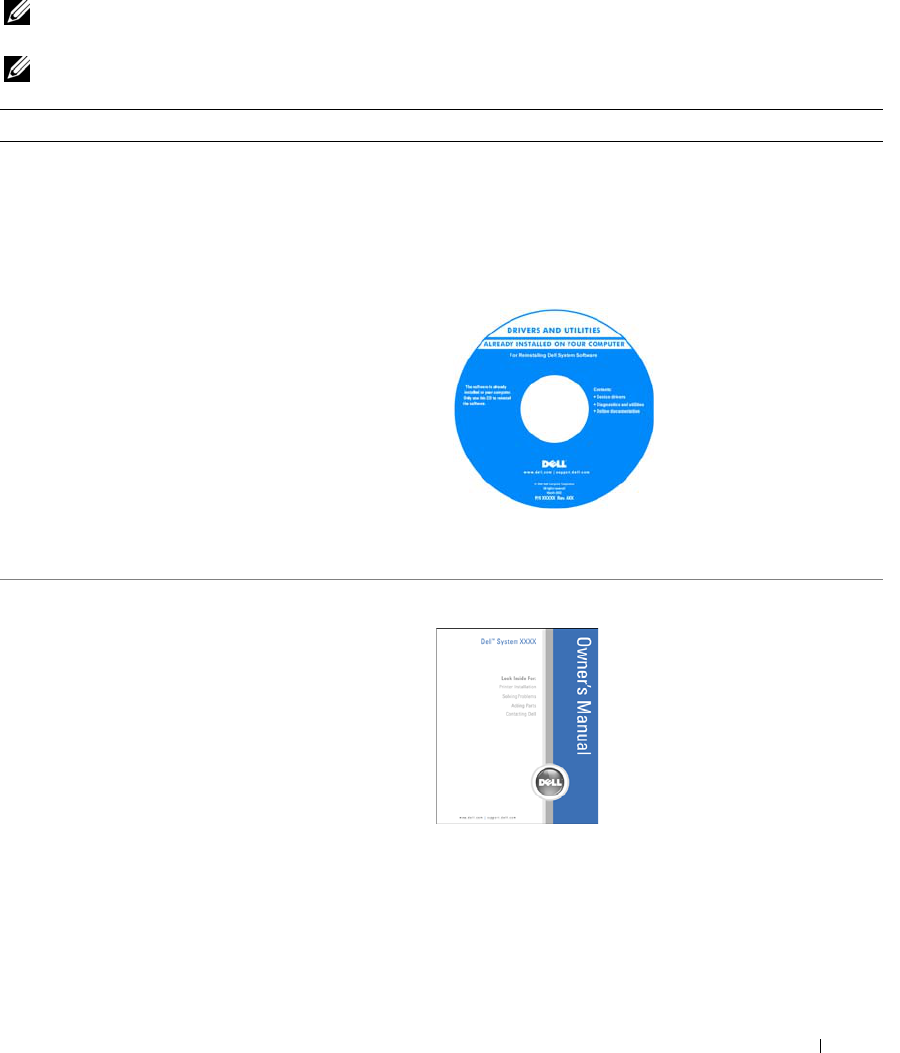
Finding Information 11
Finding Information
NOTE: Some features or media may be optional and may not ship with your computer. Some features or
media may not be available in certain countries.
NOTE: Additional information may ship with your computer.
What Are You Looking For? Find It Here
• A diagnostic program for my computer
• Drivers for my computer
• My device documentation
• Notebook System Software (NSS)
Drivers and Utilities CD (also known as ResourceCD)
NOTE: The Drivers and Utilities CD may be optional and may
not ship with your computer.
Documentation and drivers are already installed on your
computer. You can use the CD to reinstall drivers (see
page 97) or to run the Dell Diagnostics (see page 77).
Readme files may be
included on your CD to
provide last-minute
updates about technical
changes to your computer
or advanced technical-
reference material for
technicians or experienced
users.
NOTE: Drivers and documentation updates can be found at
support.dell.com.
• How to set up my computer
• Basic troubleshooting information
• How to run the Dell Diagnostics
• How to set up a printer
• Additional information about setting up my computer
• How to troubleshoot and solve problems
• How to remove and install parts
•Specifications
• How to contact Dell
Owner’s Manual
NOTE: This document is available as a PDF at
support.dell.com.
book.book Page 11 Wednesday, September 28, 2005 2:16 PM
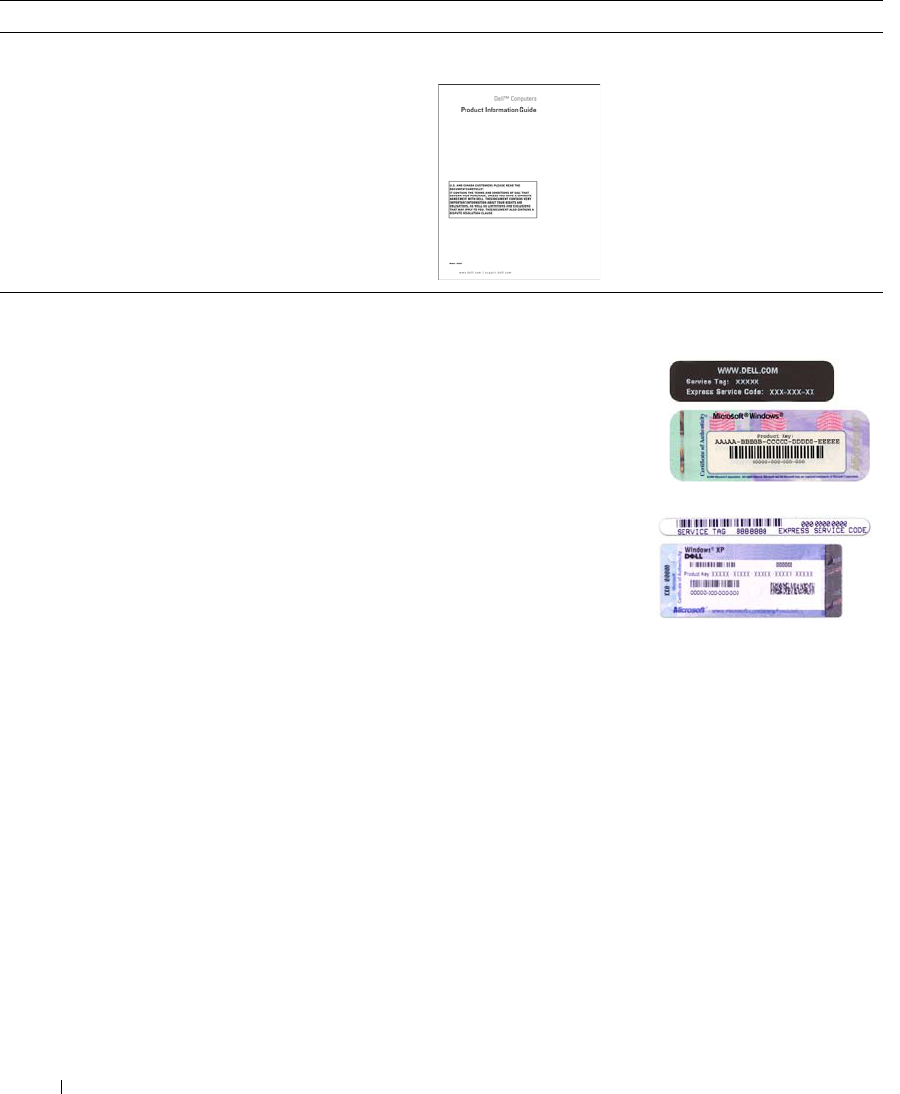
12 Finding Information
www.dell.com | support.dell.com
• Warranty information
• Terms and Conditions (U.S. only)
• Safety instructions
• Regulatory information
• Ergonomics information
• End User License Agreement
Dell™ Product Information Guide
• Service Tag and Express Service Code
• Microsoft Windows License Label
Service Tag and Microsoft
®
Windows
®
License
These labels are located on
the bottom of
your computer.
•Use the Service Tag to
identify your computer
when you use
support.dell.com
or
contact technical
support.
• Enter the Express
Service Code to direct
your call when
contacting technical
support.
What Are You Looking For? Find It Here
book.book Page 12 Wednesday, September 28, 2005 2:16 PM

Finding Information 13
• Solutions — Troubleshooting hints and tips, articles
from technicians, and online courses, frequently asked
questions
• Community — Online discussion with other Dell
customers
• Upgrades — Upgrade information for components, such
as memory, the hard drive, and the operating system
• Customer Care — Contact information, service call and
order status, warranty, and repair information
• Service and support — Service call status and support
history, service contract, online discussions with
technical support
• Reference — Computer documentation, details on my
computer configuration, product specifications, and
white papers
• Downloads — Certified drivers, patches, and software
updates
Dell Support Website — support.dell.com
NOTE: Select your region to view the appropriate support
site.
NOTE: Corporate, government, and education customers
can also use the customized Dell Premier Support website at
premier.support.dell.com.
• Notebook System Software (NSS)— If you reinstall the
operating system for your computer, you should also
reinstall the NSS utility. NSS provides critical updates
for your operating system and support for Dell™
3.5-inch USB floppy drives, Intel
®
Pentium
®
M
processors, optical drives, and USB devices. NSS is
necessary for correct operation of your Dell computer.
The software automatically detects your computer and
operating system and installs the updates appropriate
for your configuration.
To download Notebook System Software:
1
Go to
support.dell.com
and click
Downloads
.
2
Enter your Service Tag or product model.
3
In the
Download Category
drop-down menu, click
All
.
4
Select the operating system and operating system
language for your computer, and click
Submit.
5
Under
Select a Device
, scroll to
System and
Configuration Utilities
, and click
Dell Notebook System
Software
.
• How to use Windows XP
• How to work with programs and files
• How to personalize my desktop
Windows Help and Support Center
1
Click the
Start
button and click
Help and Support
.
2
Type a word or phrase that describes your problem and
click the arrow icon.
3
Click the topic that describes your problem.
4
Follow the instructions on the screen.
What Are You Looking For? Find It Here
book.book Page 13 Wednesday, September 28, 2005 2:16 PM
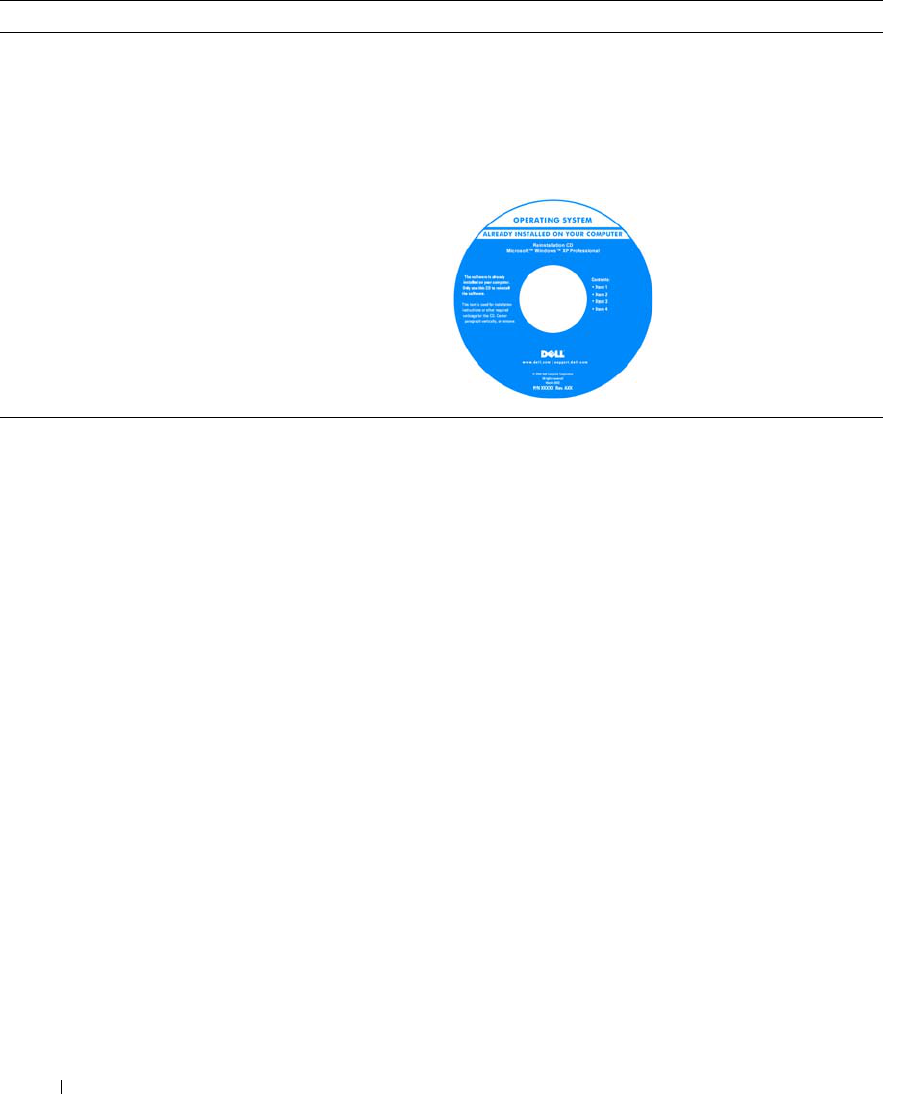
14 Finding Information
www.dell.com | support.dell.com
• How to reinstall my operating system
Operating System CD
NOTE: The Operating System CD may be optional and may
not ship with your computer.
The operating system is already installed on your computer.
To reinstall your operating system, use the Operating
System CD. See "Reinstalling Windows XP" on page 103.
After you reinstall your
operating system, use the
Drivers and Utilities CD
(ResourceCD) to reinstall
drivers for the devices that
came with your computer.
NOTE: The color of your CD
varies based on the
operating system you
ordered.
What Are You Looking For? Find It Here
book.book Page 14 Wednesday, September 28, 2005 2:16 PM
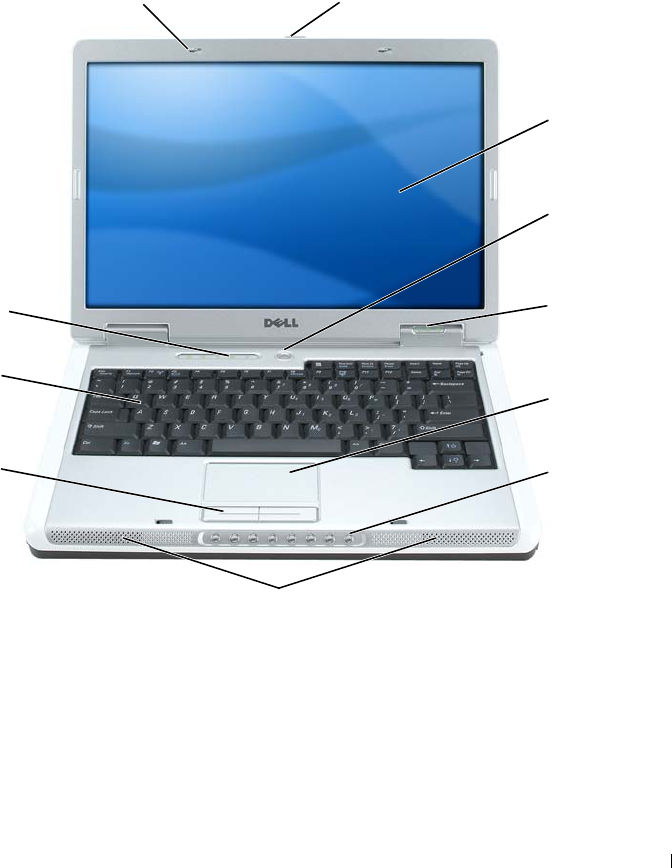
A Tour of Your Computer 15
1
A Tour of Your Computer
Front View
1display latch release 5touch pad 9keyboard
2display 6media control buttons 10 keyboard and wireless
status lights
3power button 7speakers 11 display latches (2)
4device status lights 8touch pad buttons
1
9
2
5
8
3
7
10 4
6
11
book.book Page 15 Wednesday, September 28, 2005 2:16 PM
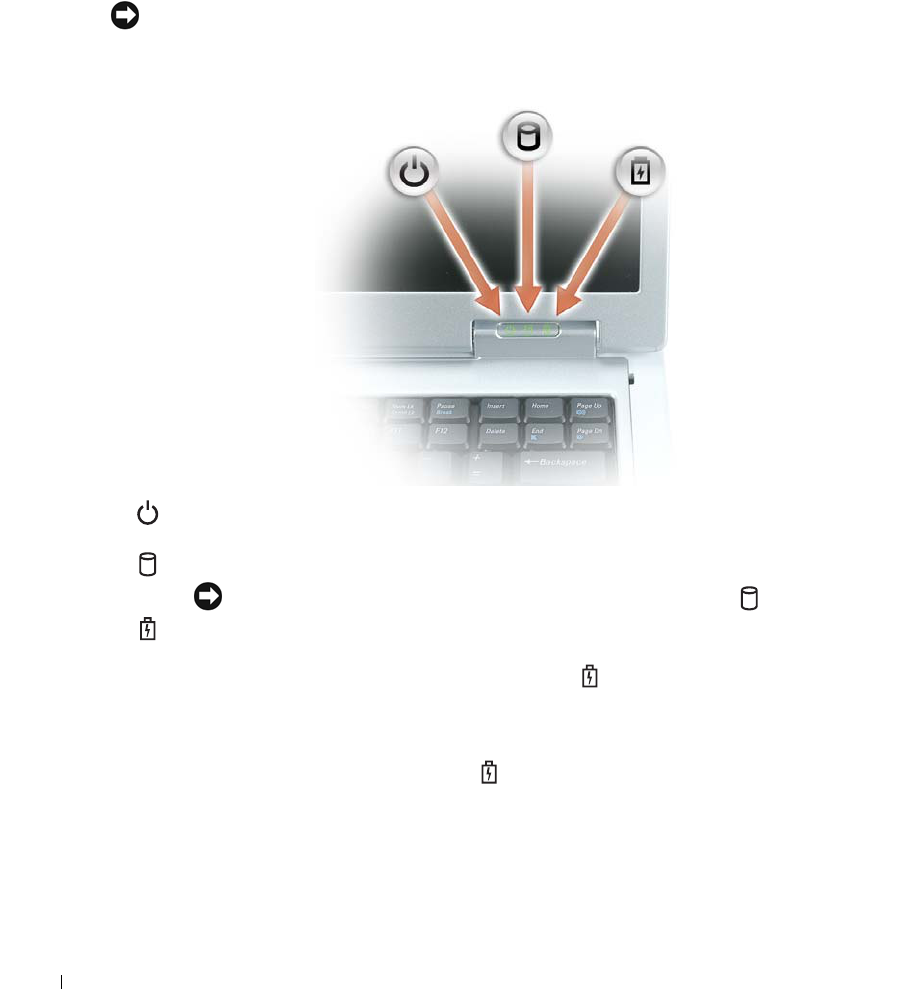
16 A Tour of Your Computer
www.dell.com | support.dell.com
DISPLAY LATCH RELEASE —Press to release the display latches and open the display.
DISPLAY —For more information about your display, see "Using the Display" on page 33.
POWER BUTTON —Press the power button to turn on the computer or to enter or exit a power
management mode.
NOTICE: To avoid losing data when you turn off your computer, shut down your computer through the
Start menu instead of pressing the power button.
DEVICE STATUS LIGHTS
If the computer is connected to an electrical outlet, the light operates as follows:
• Solid green: The battery is charging.
• Flashing green: The battery is almost fully charged.
If the computer is running on a battery, the light operates as follows:
• Off: The battery is adequately charged (or the computer is turned off).
• Flashing orange: The battery charge is low.
• Solid orange: The battery charge is critically low.
Turns on when you turn on the computer, and blinks when the computer is in a power
management mode.
Turns on when the computer reads or writes data.
NOTICE: To avoid loss of data, never turn off the computer while the light is flashing.
Turns on steadily or blinks to indicate battery charge status.
book.book Page 16 Wednesday, September 28, 2005 2:16 PM
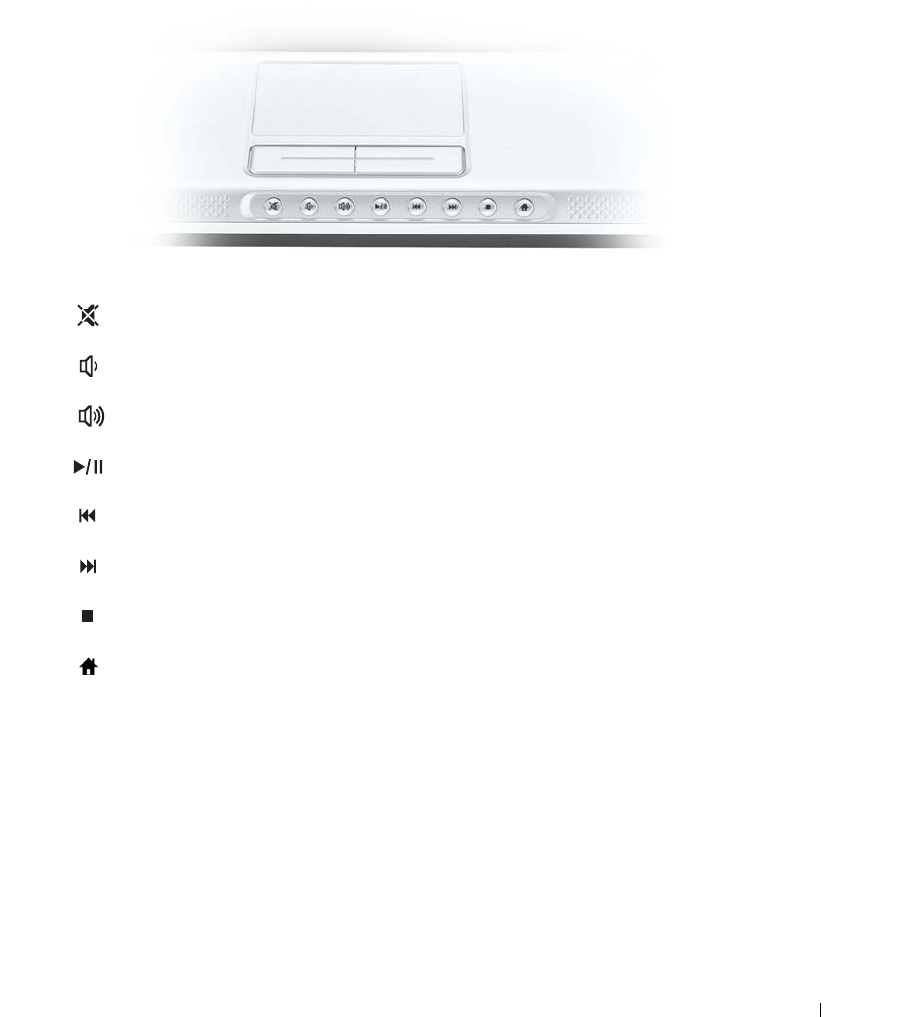
A Tour of Your Computer 17
TOUCH PAD —Provides the functionality of a mouse.
MEDIA CONTROL BUTTONS —Control CD, DVD, and Media Player playback.
SPEAKERS —To adjust the volume of the integrated speakers, press the media control buttons or speaker-
volume keyboard shortcuts. For more information, see "Speaker Functions" on page 37.
TOUCH PAD BUTTONS —Touch pad buttons provide the functionality of a mouse.
KEYBOARD —The keyboard includes a numeric keypad as well as the Microsoft Windows logo key. For
information on supported keyboard shortcuts, see "Key Combinations" on page 36.
Mute the sound.
Tu r n t he v o l u m e dow n .
Tu r n t he v o l u m e up.
Play or pause.
Play the previous track.
Play the next track.
Stop.
Launch Dell MediaDirect or Microsoft® Windows® Media Center Edition. See
"Using Dell MediaDirect" on page 54.
book.book Page 17 Wednesday, September 28, 2005 2:16 PM
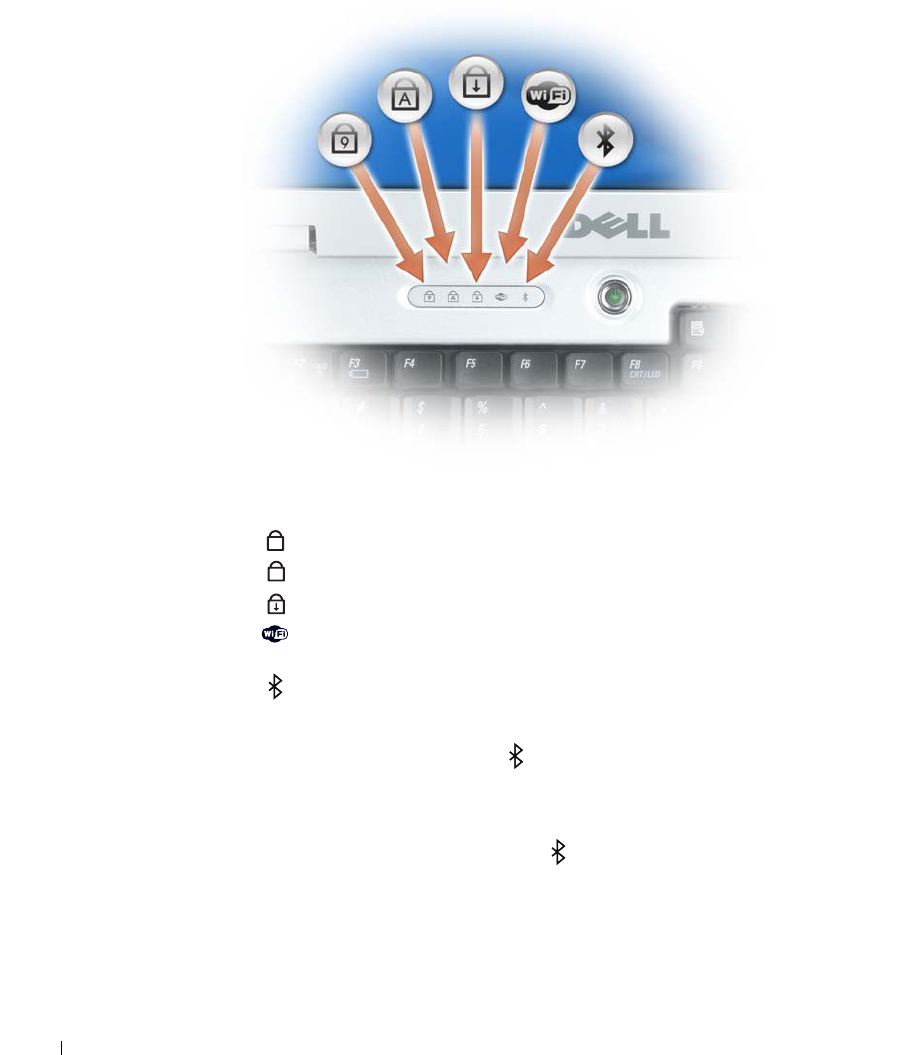
18 A Tour of Your Computer
www.dell.com | support.dell.com
KEYBOARD AND WIRELESS STATUS LIGHTS
The green lights located above the keyboard indicate the following:
DISPLAY LATCHES —Keeps the display closed.
Turns on when the numeric keypad is enabled.
Turns on when the uppercase letter function is enabled.
Turns on when the scroll lock function is enabled.
Turns on when wireless networking is enabled. To enable
or disable wireless networking, press <Fn><F2>.
Turns on when a card with Bluetooth® wireless
technology is enabled.
NOTE: The card with Bluetooth wireless technology is an
optional feature, so the light turns on only if you
ordered the card with your computer. For more information,
see the documentation that came with your card.
To turn off only the Bluetooth wireless technology
functionality, right-click the icon in the notification
area and click Disable Bluetooth Radio.
To quickly enable or disable all wireless devices, press
<Fn><F2>.
9
A
book.book Page 18 Wednesday, September 28, 2005 2:16 PM
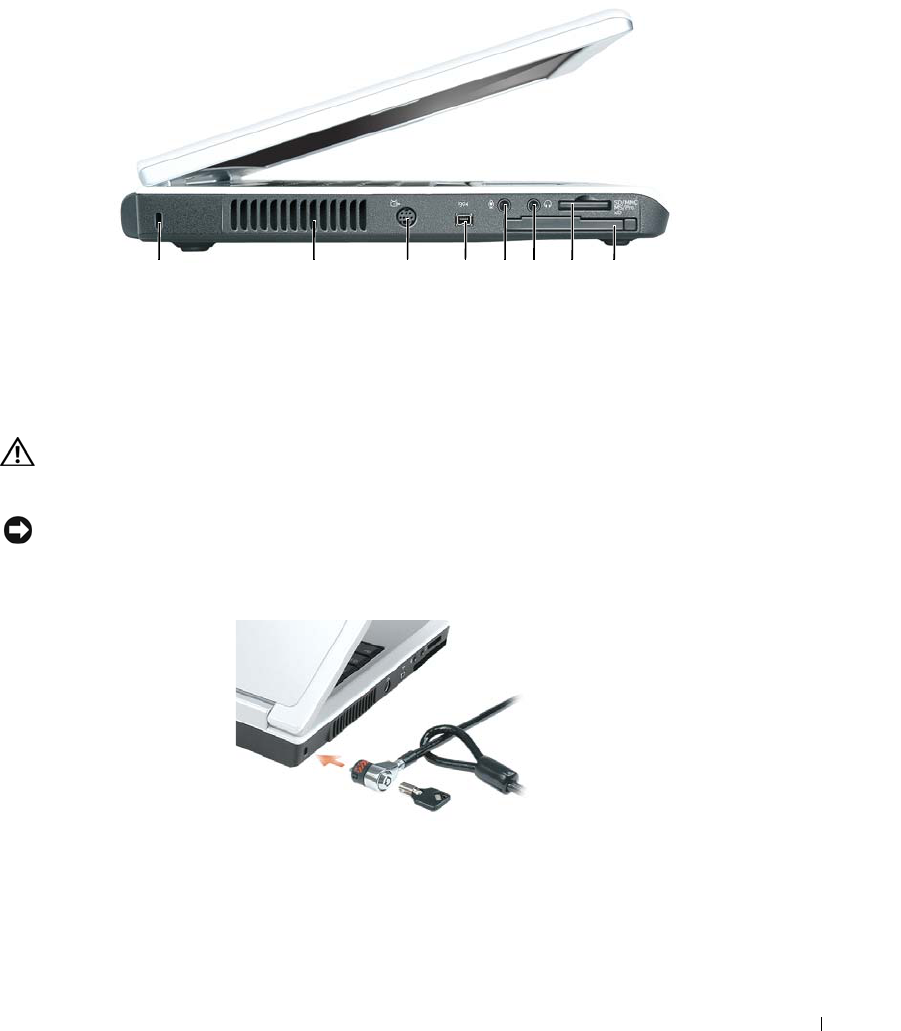
A Tour of Your Computer 19
Left Side View
CAUTION: Do not block, push objects into, or allow dust to accumulate in the air vents. Do not store
your computer in a low-airflow environment, such as a closed briefcase, while it is running. Restricting
the airflow can damage the computer or cause a fire.
NOTICE: Before you buy an antitheft device, ensure that it will work with the security cable slot.
SECURITY CABLE SLOT —Lets you attach a commercially available antitheft device to the computer.
For more information, see the instructions included with the device.
AIR VENT —The computer uses fans to create airflow through the vents, which prevents the computer
from overheating.
1security cable slot 4IEEE 1394 connector 75-in-1 media memory card
reader
2air vent 5microphone connector 8ExpressCard slot
3S-video TV-out connector 6headphone connector
345267 81
book.book Page 19 Wednesday, September 28, 2005 2:16 PM
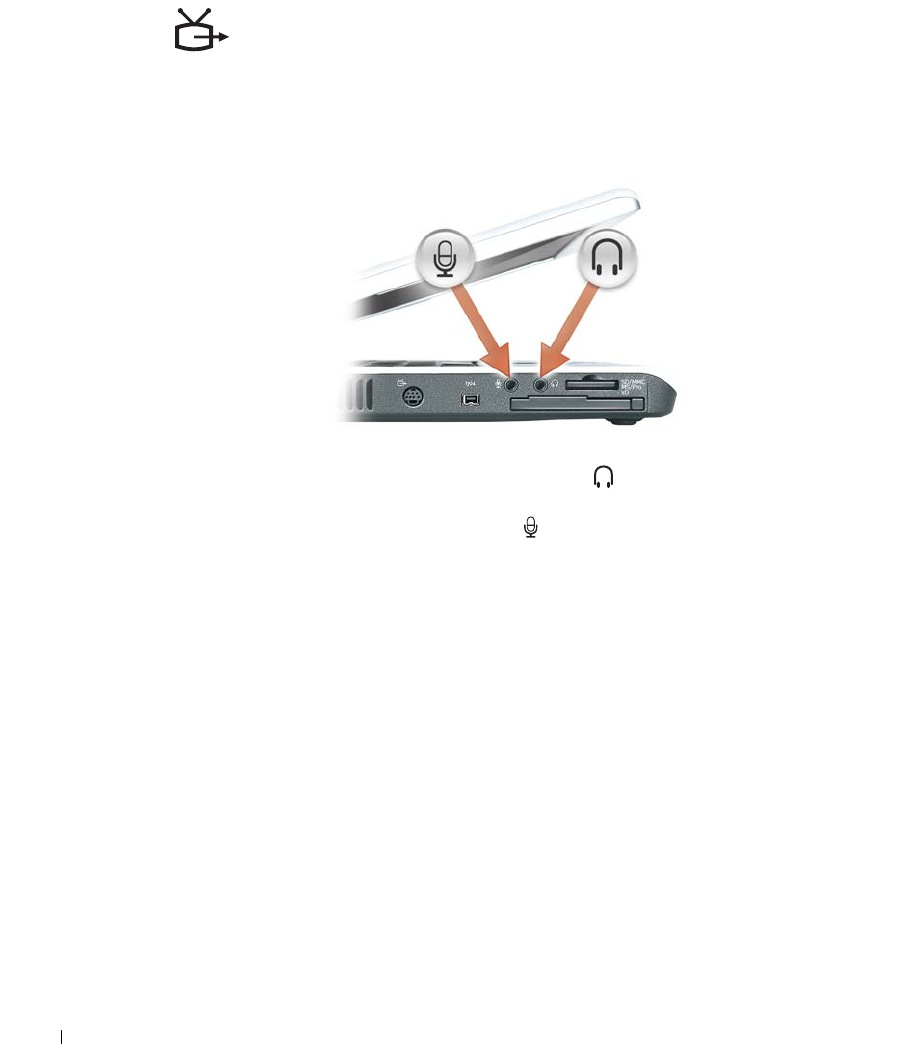
20 A Tour of Your Computer
www.dell.com | support.dell.com
S-VIDEO TV-OUT CONNECTOR
IEEE 1394 CONNECTOR —Connects devices supporting IEEE 1394 high-speed transfer rates, such as
some digital video cameras.
AUDIO CONNECTORS
5-IN-1 MEDIA MEMORY CARD READER —Provides a fast and convenient way to view and share digital
photos, music, and videos stored on a memory card. The 5-in-1 media memory card reader reads the
following digital media memory cards:
• Secure Digital (SD) card/SDIO
• MultiMediaCard (MMC)
•Memory Stick
•Memory Stick PRO
•xD-Picture Card
EXPRESSCARD SLOT —Supports one ExpressCard. The computer ships with a plastic blank installed in
the slot. For more information, see "Using ExpressCards" on page 67.
Connects your computer to a TV. Also connects digital audio capable devices
using the TV/digital audio adapter cable.
Attach headphones or speakers to the connector.
Attach a microphone to the connector.
book.book Page 20 Wednesday, September 28, 2005 2:16 PM
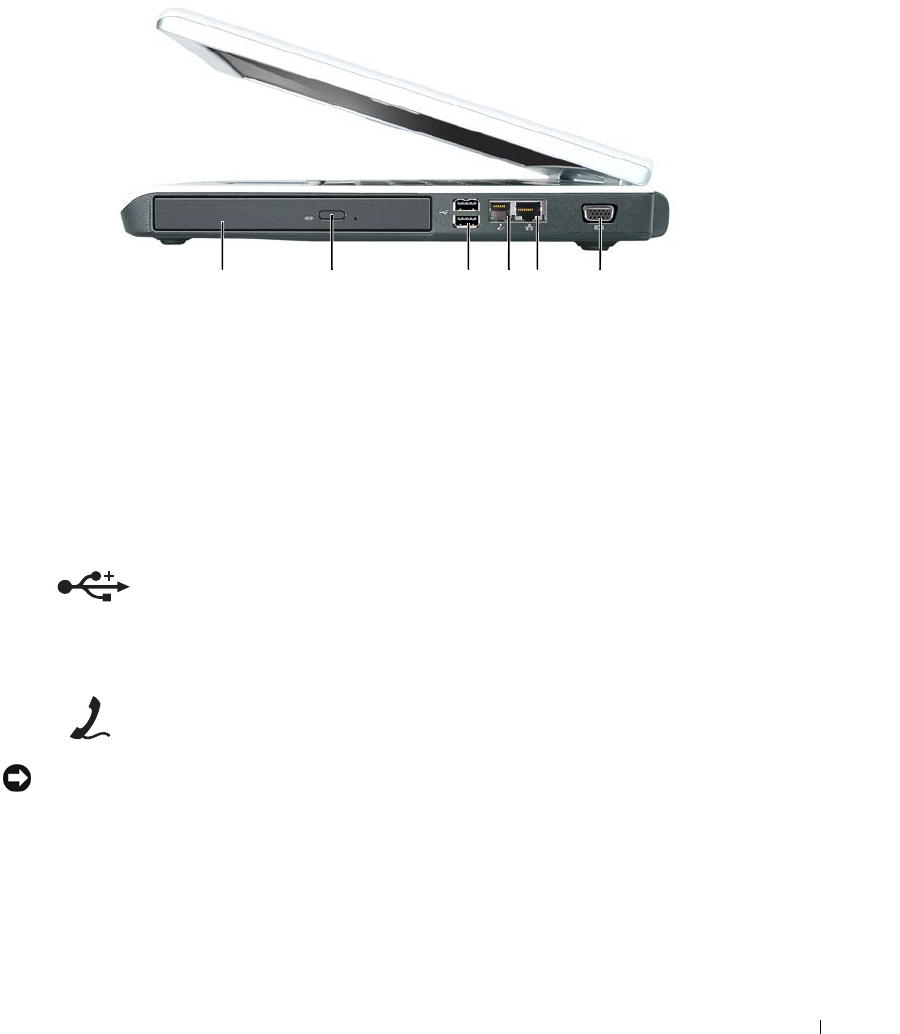
A Tour of Your Computer 21
Right Side View
OPTICAL DRIVE BAY —You can install devices such as a DVD drive or other optical drive in the optical
drive bay. For more information, see "Optical Drives" on page 111.
OPTICAL DRIVE-TRAY EJECT BUTTON —Press this button to eject a CD or DVD from the optical drive.
USB CONNECTORS
MODEM CONNECTOR (RJ-11)
NOTICE: The network connector is slightly larger than the modem connector. To avoid damaging the
computer, do not plug a telephone line into the network connector.
1optical drive bay 3USB connectors (2) 5network connector (RJ-45)
2optical drive-tray eject
button
4modem connector (RJ-11) 6video connector
Connect USB devices, such as a mouse, keyboard, or printer. You can also connect
the optional floppy drive directly to a USB connector using the optional floppy-
drive cable.
To use the internal modem, connect the telephone line to the modem connector.
For additional information on using the modem, see the online modem
documentation supplied with your computer.
345261
book.book Page 21 Wednesday, September 28, 2005 2:16 PM
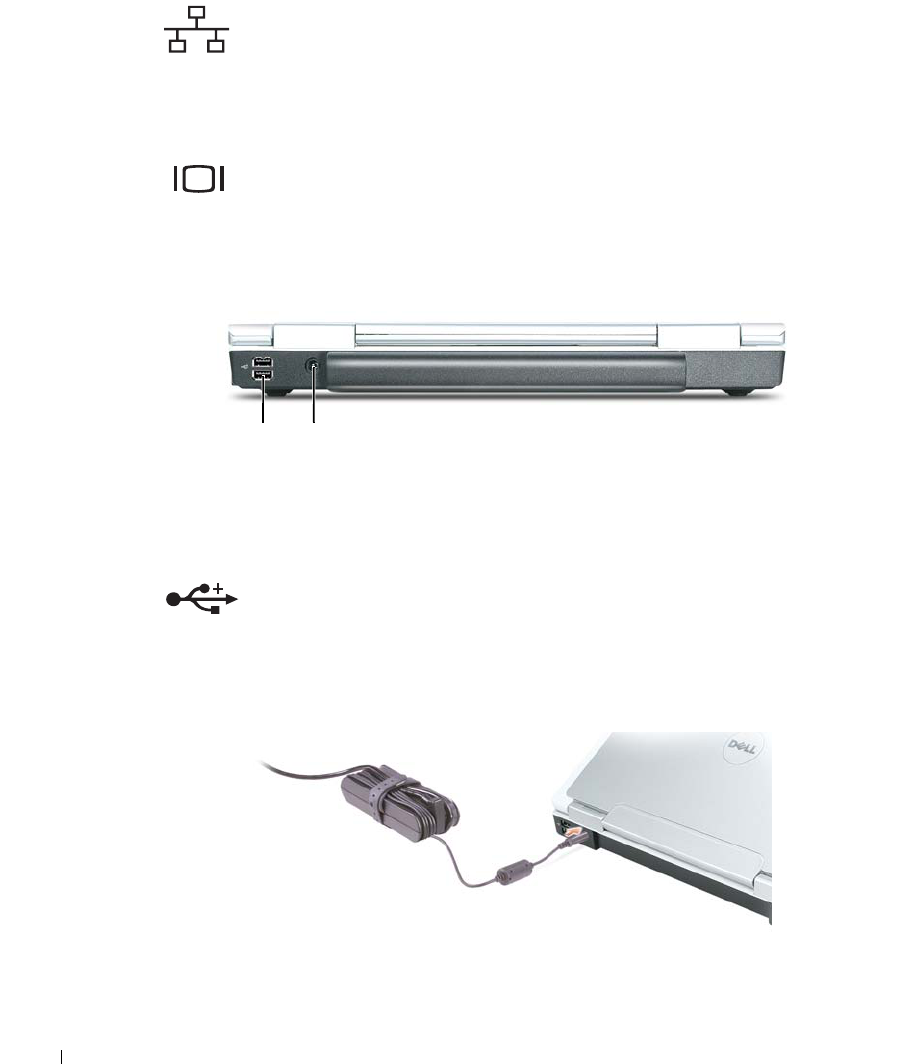
22 A Tour of Your Computer
www.dell.com | support.dell.com
NETWORK CONNECTOR (RJ-45)
VIDEO CONNECTOR
Back View
USB CONNECTORS
AC ADAPTER CONNECTOR —Attaches an AC adapter to the computer. The AC adapter converts AC
power to the DC power required by the computer. You can connect the AC adapter with your computer
turned either on or off.
Connects the computer to a network. The green and yellow lights next to the
connector indicate activity for wired network communications.
For information on using the network adapter, see the online network adapter
documentation supplied with your computer.
Connects an external VGA-compatible monitor.
1USB connectors (2) 2AC adapter connector
Connect USB devices, such as a mouse, keyboard, or printer. You can also connect
the optional floppy drive directly to a USB connector using the optional floppy-
drive cable.
21
book.book Page 22 Wednesday, September 28, 2005 2:16 PM
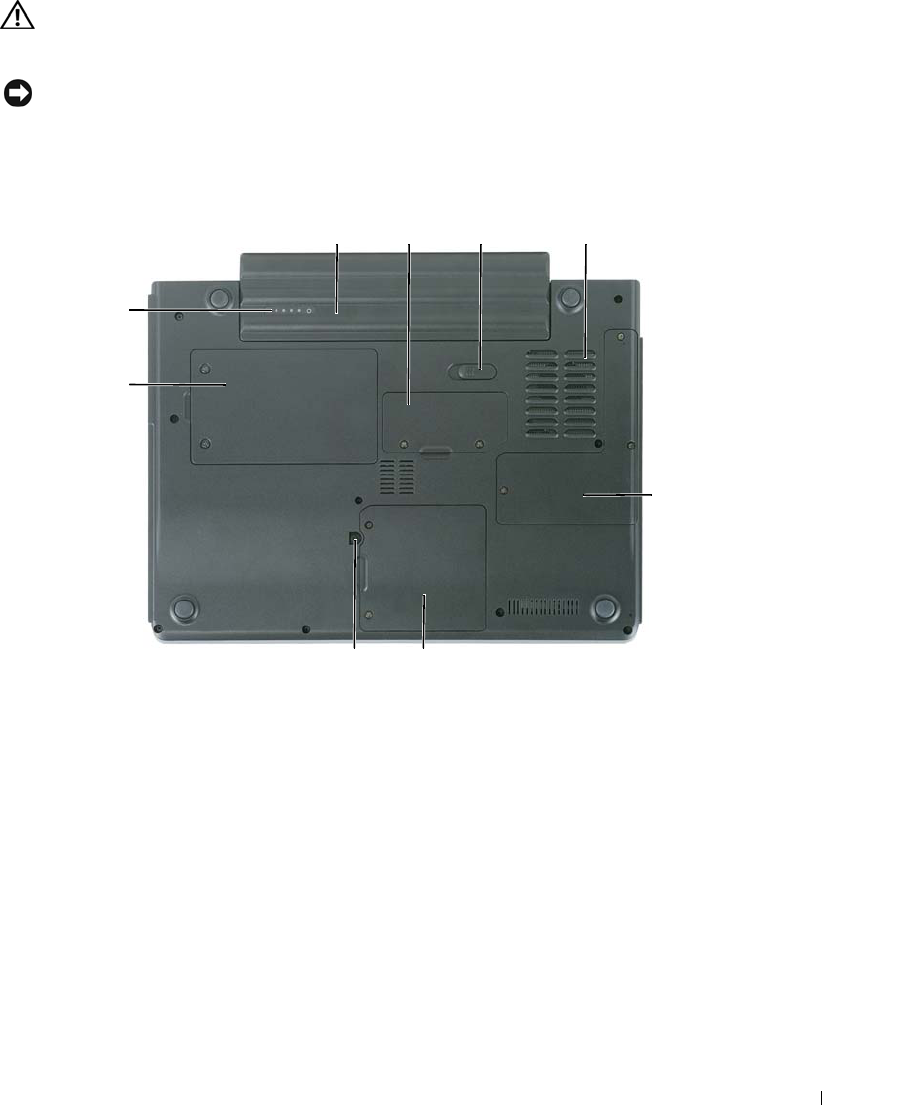
A Tour of Your Computer 23
CAUTION: The AC adapter works with electrical outlets worldwide. However, power connectors and
power strips vary among countries. Using an incompatible cable or improperly connecting the cable to
the power strip or electrical outlet may cause fire or equipment damage.
NOTICE: When you disconnect the AC adapter cable from the computer, grasp the connector, not the
cable itself, and pull firmly but gently to avoid damaging the cable.
Bottom View
BATTERY —When a battery is installed, you can use the computer without connecting the computer to
an electrical outlet. For more information, see "Using a Battery" on page 45.
MEMORY MODULE COVER —Covers the compartment that contains the memory modules. For more
information, see page 112.
BATTERY-BAY LATCH RELEASE —Releases the battery from the battery bay. See "Battery" on page 108.
FAN —The computer uses a fan to create airflow through the vents, which prevents the computer from
overheating.
PROCESSOR AND THERMAL MODULE COVER —Covers the processor and thermal module.
1battery 4fan 7optical-drive locking screw
2memory module cover 5processor and thermal
module cover
8hard drive
3battery-bay latch release 6modem/Mini PCI/
wireless cover
9battery charge gauge
6
5
7
4132
8
9
book.book Page 23 Wednesday, September 28, 2005 2:16 PM

24 A Tour of Your Computer
www.dell.com | support.dell.com
MODEM/MINI PCI/WIRELESS COVER —Covers the compartment that contains the modem, Mini PCI
card, and internal card with Bluetooth wireless technology. For more information, see page 119.
OPTICAL-DRIVE LOCKING SCREW —Secures the optical drive in the optical drive bay. For more
information, see "Optical Drives" on page 111.
HARD DRIVE —Stores software and data. For more information, see "Hard Drive" on page 108 and "Hard
drive problems" on page 81. The size displayed for your hard drive in Windows Explorer is the capacity of
the drive before any operating system or programs are installed.
BATTERY CHARGE GAUGE —Provides information on the battery charge status. See "Using a Battery" on
page 45.
book.book Page 24 Wednesday, September 28, 2005 2:16 PM

Setting Up Your Computer 25
2
Setting Up Your Computer
Connecting to the Internet
NOTE: ISPs and ISP offerings vary by country.
To connect to the Internet, you need a modem or network connection and an Internet service
provider (ISP). Your ISP will offer one or more of the following Internet connection options:
• Dial-up connections that provide Internet access through a telephone line. Dial-up
connections are considerably slower than DSL and cable modem connections.
• DSL connections that provide high-speed Internet access through your existing telephone
line. With a DSL connection, you can access the Internet and use your telephone on the same
line simultaneously.
• Cable modem connections that provide high-speed Internet access through your local cable
TV line.
If you are using a dial-up connection, connect a telephone line to the modem connector on your
computer and to the telephone wall jack before you set up your Internet connection. If you are
using a DSL or cable modem connection, contact your ISP for setup instructions.
Setting Up Your Internet Connection
To set up an Internet connection with a provided ISP desktop shortcut:
1
Save and close any open files, and exit any open programs.
2
Double-click the ISP
icon on the Microsoft
®
Windows
®
desktop.
3
Follow the instructions on the screen to complete the setup.
If you do not have an ISP icon on your desktop or if you want to set up an Internet connection
with a different ISP:
1
Save and close any open files, and exit any open programs.
2
Click the
Start
button and click
Internet Explorer
.
The
New Connection Wizard
appears.
3
Click
Connect to the Internet
.
4
In the next window, click the appropriate option:
• If you do not have an ISP and want to select one, click
Choose from a list of Internet
service providers (ISPs)
.
book.book Page 25 Wednesday, September 28, 2005 2:16 PM

26 Setting Up Your Computer
www.dell.com | support.dell.com
• If you have already obtained setup information from your ISP but you did not receive a
setup CD, click
Set up my connection manually
.
• If you have a CD, click
Use the CD I got from an ISP
.
5
Click
Next
.
If you selected
Set up my connection manually
, continue to step 6. Otherwise, follow the
instructions on the screen to complete the setup.
NOTE: If you do not know which type of connection to select, contact your ISP.
6
Click the appropriate option under
How do you want to connect to the Internet?
, and then
click
Next
.
7
Use the setup information provided by your ISP to complete the setup.
If you are having problems connecting to the Internet, see "E-Mail, Modem, and Internet
Problems" on page 82. If you cannot connect to the Internet but have successfully connected in
the past, the ISP might have a service outage. Contact your ISP to check the service status, or
try connecting again later.
Transferring Information to a New Computer
The Microsoft® Windows® XP operating system provides a Files and Settings Transfer Wizard
to move data from a source computer to a new computer. You can transfer data, such as:
• E-mail messages
• Toolbar settings
•Window sizes
• Internet bookmarks
You can transfer the data to the new computer over a network connection, or you can store it on
a removable medium, such as a writable CD or floppy, for transfer to the new computer.
NOTE: For instructions on setting up a direct cable connection between two computers, see Microsoft
Knowledge Base Article #305621, titled How to Set Up a Direct Cable Connection Between Two
Computers in Windows XP. This information may not be available in some countries.
For transferring information to a new computer, you must run the Files and Settings Transfer
Wizard. You can use the optional Operating System CD for this process or you can create a
wizard disk with the Files and Settings Transfer Wizard utility.
book.book Page 26 Wednesday, September 28, 2005 2:16 PM

Setting Up Your Computer 27
Running the Files and Settings Transfer Wizard With the Operating System CD
NOTE: This procedure requires the Operating System CD. This CD is optional and may not be included
with all computers.
To prepare the new computer for the file transfer:
1
Start the
Files and Settings Transfer Wizard.
2
When the
Files and Settings Transfer Wizard
welcome screen appears, click
Next
.
3
On the
Which computer is this?
screen, click
New Computer
and click
Next
.
4
On the
Do you have a Windows XP CD?
screen, click
I will use the wizard from the
Windows XP CD
and click
Next
.
5
When the
Now go to your old computer
screen appears, go to your old or source computer.
Do
not
click
Next
at this time.
To copy data from the old computer:
1
On the old computer, insert the Windows XP
Operating System
CD.
2
On the
Welcome to Microsoft Windows XP
screen, click
Perform additional tasks
.
3
Under
What do you want to do?
, click
Transfer files and settings
.
4
On the
Files and Settings Transfer Wizard
welcome screen, click
Next
.
5
On the
Which computer is this?
screen, click
Old Computer
and click
Next
.
6
On the
Select a transfer method
screen, click the transfer method you prefer.
7
On the
What do you want to transfer?
screen, select the items you want to transfer and click
Next
.
After the information has been copied, the
Completing the Collection Phase
screen appears.
8
Click
Finish
.
To transfer data to the new computer:
1
On the
Now go to your old computer
screen on the new computer, click
Next
.
2
On the
Where are the files and settings?
screen, select the method you chose for transferring
your settings and files and click
Next
.
The wizard reads the collected files and settings and applies them to your new computer.
When all of the settings and files have been applied, the
Finished
screen appears.
3
Click
Finished
and restart the new computer.
Running the Files and Settings Transfer Wizard Without the Operating System CD
To run the Files and Settings Transfer Wizard without the optional Operating System CD, you
must create a wizard disk that will allow you to create a backup image file to removable media.
book.book Page 27 Wednesday, September 28, 2005 2:16 PM

28 Setting Up Your Computer
www.dell.com | support.dell.com
To create a wizard disk, use your new computer with Windows XP and perform the following
steps:
1
Click the
Start
button.
2
Click
Files and Settings Transfer Wizard
.
3
When the
Files and Settings Transfer Wizard
welcome screen appears, click
Next
.
4
On the
Which computer is this?
screen, click
New Computer
and click
Next
.
5
On the
Do you have a Windows XP CD?
screen, click
I want to create a Wizard Disk in the
following drive:
and click
Next.
6
Insert the removable media, such as a floppy disk or CD, and click
OK
.
7
When the disk creation completes and the
Now go to your old computer
message appears,
do
not
click
Next
.
8
Go to the old computer.
To copy data from the old computer:
1
On the old computer, insert the wizard disk.
2
Click the
Start
button and click
Run
.
3
In the
Open
field on the
Run
window, browse to the path for
fastwiz
(on the appropriate
removable media) and click
OK
.
4
On the
Files and Settings Transfer Wizard
welcome screen, click
Next
.
5
On the
Which computer is this?
screen, click
Old Computer
and click
Next
.
6
On the
Select a transfer method
screen, click the transfer method you prefer.
7
On the
What do you want to transfer?
screen, select the items you want to transfer and click
Next
.
After the information has been copied, the
Completing the Collection Phase
screen appears.
8
Click
Finish
.
book.book Page 28 Wednesday, September 28, 2005 2:16 PM

Setting Up Your Computer 29
To transfer data to the new computer:
1
On the
Now go to your old computer
screen on the new computer, click
Next
.
2
On the
Where are the files and settings?
screen, select the method you chose for transferring
your settings and files and click
Next
. Follow the instructions on the screen.
The wizard reads the collected files and settings and applies them to your new computer.
When all of the settings and files have been applied, the
Finished
screen appears.
3
Click
Finished
and restart the new computer.
NOTE: For more information about this procedure, search dell.support.com for document #PA1089586
(How Do I Transfer Files From My Old Computer to My New Dell Computer Using the Microsoft®
Windows® XP Operating System?).
NOTE: Access to the Dell Knowledge Base document may not be available in some countries.
Setting Up a Printer
NOTICE: Complete the operating system setup before you connect a printer to the computer.
See the documentation that came with the printer for setup information, including how to:
• Obtain and install updated drivers.
• Connect the printer to the computer.
• Load paper and install the toner or ink cartridge.
For technical assistance, refer to the printer owner's manual or contact the printer manufacturer.
Printer Cable
Your printer connects to your computer with either a USB cable or a parallel cable. Your printer
may not come with a printer cable, so if you purchase a cable separately, ensure that it is
compatible with your printer and computer. If you purchased a printer cable at the same time
you purchased your computer, the cable may arrive in the box in which your computer was
shipped.
book.book Page 29 Wednesday, September 28, 2005 2:16 PM
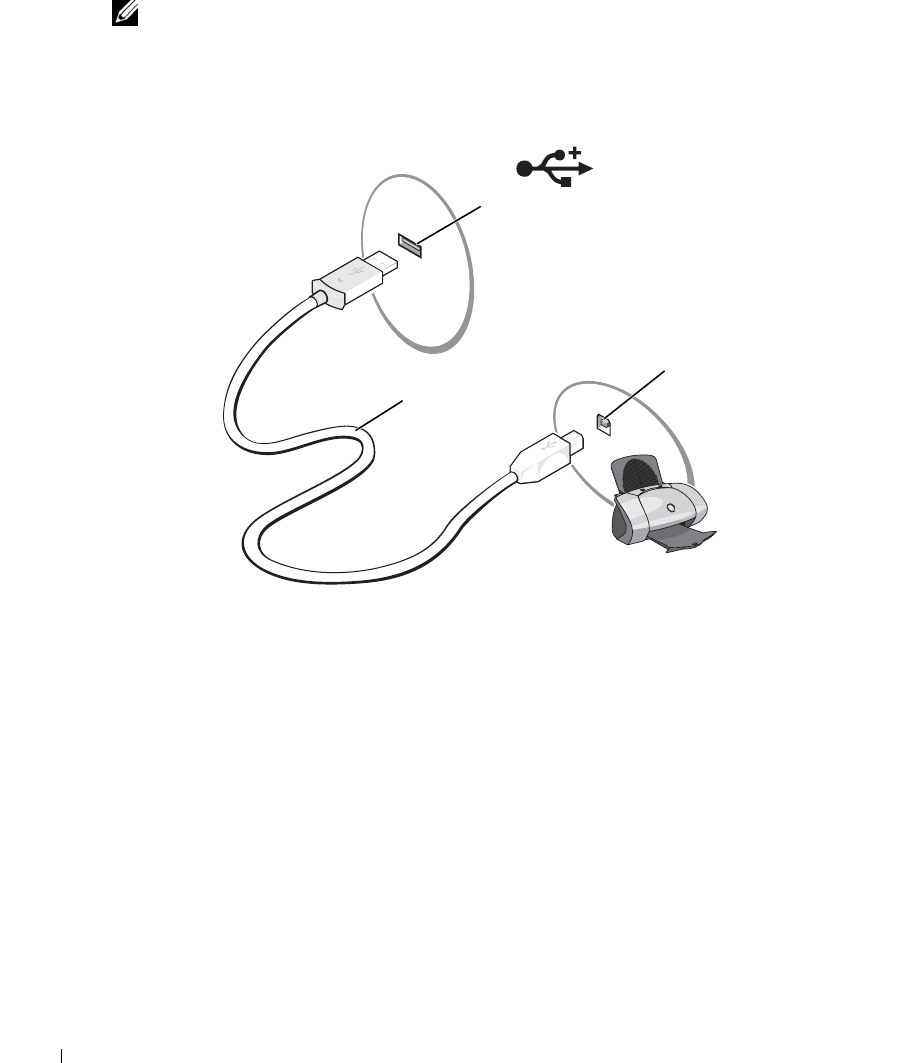
30 Setting Up Your Computer
www.dell.com | support.dell.com
Connecting a USB Printer
NOTE: You can connect USB devices while the computer is turned on.
1
Complete the operating system setup if you have not already done so.
2
Attach the USB printer cable to the USB connectors on the computer and the printer. The
USB connectors fit only one way.
3
Turn on the printer and then turn on the computer. If the
Add New Hardware Wizard
window appears, click
Cancel
.
4
Install the printer driver if necessary. See the documentation that came with your printer.
Power Protection Devices
Several devices are available to protect against power fluctuations and failures:
•Surge protectors
• Line conditioners
• Uninterruptible power supplies (UPS)
1USB connector on
computer
2USB printer cable 3connector on printer
2
1
3
book.book Page 30 Wednesday, September 28, 2005 2:16 PM

Setting Up Your Computer 31
Surge Protectors
Surge protectors and power strips equipped with surge protection help prevent damage to your
computer from voltage spikes that can occur during electrical storms or after power
interruptions. Some surge protector manufacturers include warranty coverage for certain types
of damage. Carefully read the device warranty when choosing a surge protector. A device with a
higher joule rating offers more protection. Compare joule ratings to determine the relative
effectiveness of different devices.
NOTICE: Most surge protectors do not protect against power fluctuations or power interruptions
caused by nearby lightning strikes. When lightning occurs in your area, disconnect the telephone line
from the telephone wall jack and disconnect your computer from the electrical outlet.
Many surge protectors have a telephone jack for modem protection. See the surge protector
documentation for modem connection instructions.
NOTICE: Not all surge protectors offer network adapter protection. Disconnect the network cable from
the network wall jack during electrical storms.
Line Conditioners
NOTICE: Line conditioners do not protect against power interruptions.
Line conditioners are designed to maintain AC voltage at a fairly constant level.
Uninterruptible Power Supplies
NOTICE: Loss of power while data is being saved to the hard drive may result in data loss or file damage.
NOTE: To ensure maximum battery operating time, connect only your computer to a UPS. Connect other
devices, such as a printer, to a separate power strip that provides surge protection.
A UPS protects against power fluctuations and interruptions. UPS devices contain a battery that
provides temporary power to connected devices when AC power is interrupted. The battery
charges while AC power is available. See the UPS manufacturer documentation for information
on battery operating time and to ensure that the device is approved by Underwriters
Laboratories (UL).
book.book Page 31 Wednesday, September 28, 2005 2:16 PM

32 Setting Up Your Computer
www.dell.com | support.dell.com
book.book Page 32 Wednesday, September 28, 2005 2:16 PM
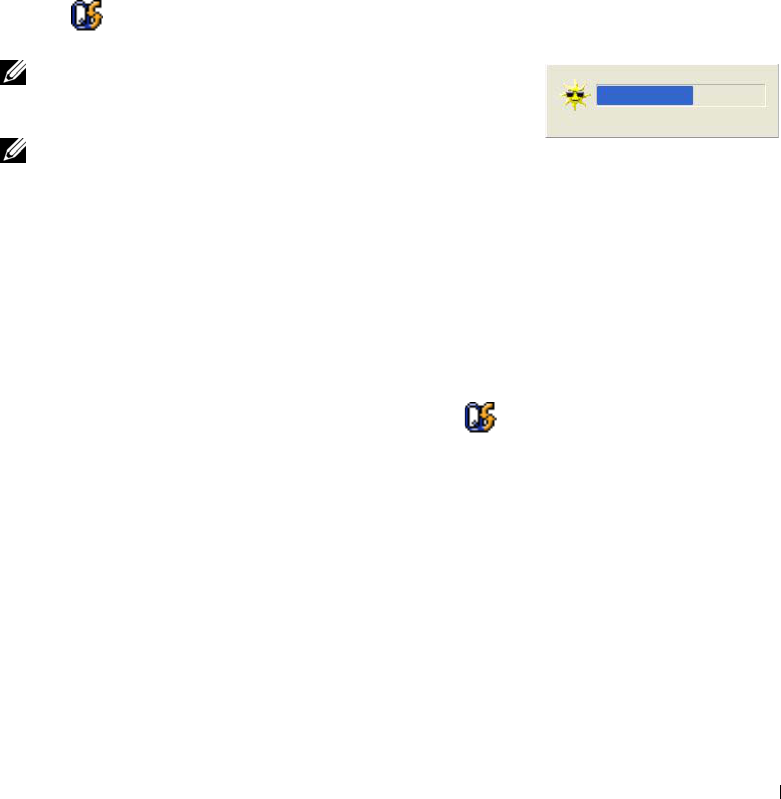
Using the Display 33
3
Using the Display
Adjusting Brightness
When a Dell™ computer is running on battery power, you can conserve power by setting the
brightness to the lowest comfortable setting by pressing <Fn> and the up- or down-arrow key
on the keyboard.
The Dell QuickSet Brightness Meter shows the current brightness setting for the display. Right-
click the icon in the taskbar to enable or disable the Brightness Meter on the screen.
NOTE: By default, the Brightness Meter appears in the lower-right
corner of the display. You can click and drag the meter to a
preferred location.
NOTE: Brightness key combinations only affect the display on your
portable computer, not monitors that you attach to your portable
computer. If your computer is connected to an external monitor and you try to change the brightness
level, the Brightness Meter appears, but the brightness level on the monitor does not change.
You can enable or disable the Brightness Meter from the QuickSet taskbar menu. When the
meter is enabled, press the following keys to adjust brightness:
• Press <Fn> and the up-arrow key to increase brightness on the integrated display only (not
on an external monitor).
• Press <Fn> and the down-arrow key to decrease brightness on the integrated display only
(not on an external monitor).
For more information on using QuickSet, right-click the icon in the taskbar and click Help.
Switching the Video Image
When you start the computer with an external device (such as an external monitor or projector)
attached and turned on, the image may appear on either the computer display or the external
device.
Press <Fn><F8> to switch the video image between the display only, the external device only,
or the display and the external device simultaneously.
book.book Page 33 Wednesday, September 28, 2005 2:16 PM

34 Using the Display
www.dell.com | support.dell.com
Setting Display Resolution
To display a program at a specific resolution, both the graphics card and the display must
support the program, and the necessary video drivers must be installed.
Before you change any of the default display settings, make a note of the default settings for
future reference.
If you choose a resolution or color palette that is higher than the display supports, the settings
adjust automatically to the closest supported values.
1
Click the
Start
button and click
Control Panel
.
2
Under
Pick a category
, click
Appearance and Themes
.
3
Under
Pick a task...
, click the area you want to change, or under
or pick a Control Panel icon
,
click
Display
.
4
Try different settings for
Color quality
and
Screen resolution
.
NOTE: As the resolution increases, icons and text appear smaller on the screen.
book.book Page 34 Wednesday, September 28, 2005 2:16 PM
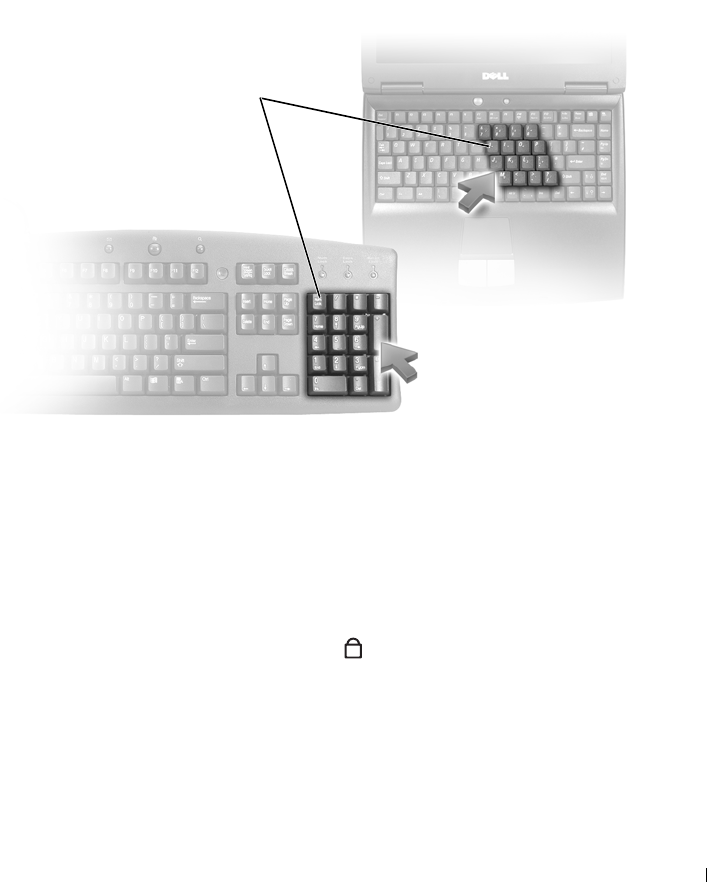
Using the Keyboard and Touch Pad 35
4
Using the Keyboard and Touch Pad
Numeric Keypad
The numeric keypad functions like the numeric keypad on an external keyboard. Each key on the
keypad has multiple functions. The keypad numbers and symbols are marked in blue on the right of
the keypad keys. To type a number or symbol, press <Fn> and the desired key after enabling the
keypad.
• To enable the keypad, press <Num Lk>. The light indicates that the keypad is active.
• To disable the keypad, press <Num Lk> again.
1numeric keypad
1
9
book.book Page 35 Wednesday, September 28, 2005 2:16 PM

36 Using the Keyboard and Touch Pad
www.dell.com | support.dell.com
Key Combinations
System Functions
Battery
CD or DVD Tray
Display Functions
Radios (Including Wireless Networking and an Internal Card With
Bluetooth® Wireless Technology)
<Ctrl><Shift><Esc> Opens the Tas k Mana ger window.
<Fn><F3> Displays the Dell™ QuickSet Battery Meter. This feature
is not supported in Dell MediaDirect. For more
information, see "Dell™ QuickSet Battery Meter" on
page 46.
<Fn><F10> Ejects the tray out of the drive (if Dell QuickSet is
installed). This feature is not supported in Dell
MediaDirect. For more information on QuickSet, see
"Dell™ QuickSet Features" on page 44.
<Fn><F8> Switches the video image to the next display option. The
options include the integrated display, an external
monitor, and both displays simultaneously.
<Fn> and up-arrow key Increases brightness on the integrated display only (not
on an external monitor).
<Fn> and down-arrow
key
Decreases brightness on the integrated display only (not
on an external monitor).
<Fn><F2> Enables and disables radios, including wireless
networking and Bluetooth wireless technology.
book.book Page 36 Wednesday, September 28, 2005 2:16 PM

Using the Keyboard and Touch Pad 37
Power Management
Speaker Functions
Microsoft® Windows® Logo Key Functions
To adjust keyboard operation, such as the character repeat rate, open the Control Panel, click
Printers and Other Hardware
, and click
Keyboard
. For information about the Control Panel, see
the Windows Help and Support Center. To access the Help and Support Center, see page 13.
<Fn><Esc> Activates a power management mode. You can
reprogram this keyboard shortcut to activate a different
power management mode using the Advanced tab in the
Power Options Properties window. See "Power
Management Modes" on page 41.
<Fn><Page Up> Increases the volume of the integrated speakers and
external speakers, if attached.
<Fn><Page Dn> Decreases the volume of the integrated speakers and
external speakers, if attached.
<Fn><End> Enables and disables the integrated speakers and external
speakers, if attached.
Windows logo key and
<m>
Minimizes all open windows.
Windows logo key and
<Shift><m>
Maximizes all windows.
Windows logo key and <e> Runs Windows Explorer. This opens the same
window as double-clicking "My Computer" on your
desktop.
Windows logo key and <r> Opens the Run dialog box.
Windows logo key and <f> Opens the Search Results dialog box.
Windows logo key and
<Ctrl><f>
Opens the Search Results-Computer dialog box
(if the computer is connected to a network).
Windows logo key and
<Pause>
Opens the System Properties dialog box.
book.book Page 37 Wednesday, September 28, 2005 2:16 PM
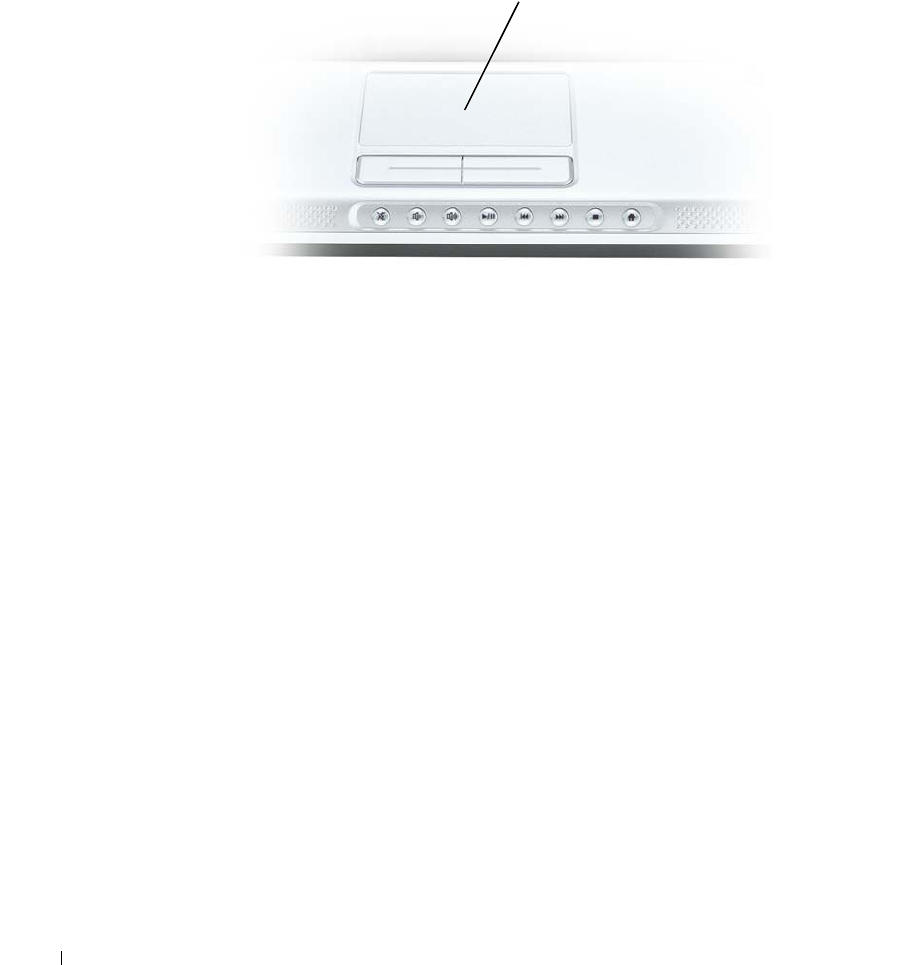
38 Using the Keyboard and Touch Pad
www.dell.com | support.dell.com
Touch Pad
The touch pad detects the pressure and movement of your finger to allow you to move the cursor
on the display. Use the touch pad and touch pad buttons as you would use a mouse.
• To move the cursor, lightly slide your finger over the touch pad.
• To select an object, lightly tap once on the surface of the touch pad or use your thumb to
press the left touch-pad button.
• To select and move (or drag) an object, position the cursor on the object and tap twice on the
touch pad. On the second tap, leave your finger on the touch pad and move the selected
object by sliding your finger over the surface.
• To double-click an object, position the cursor on the object and tap twice on the touch pad or
use your thumb to press the left touch-pad button twice.
Customizing the Touch Pad
You can use the
Mouse Properties
window to disable the touch pad or adjust their settings.
1
Open the Control Panel, click
Printers and Other Hardware
, and then click
Mouse
. For
information about the Control Panel, see the Windows Help and Support Center. To access
the Help and Support Center, see page 13.
2
In the
Mouse Properties
window, click the
Touch Pad
tab to adjust touch pad settings.
3
Click
OK
to save the settings and close the window.
1touch pad
1
book.book Page 38 Wednesday, September 28, 2005 2:16 PM

Power Management 39
5
Power Management
Power Management Tips
NOTE: See "Using a Battery" on page 45 for more information on conserving battery power.
• Connect the computer to an electrical outlet when possible because battery life is largely
determined by the number of times the battery is used and recharged.
• Place the computer in standby mode or hibernate mode when you leave the computer
unattended for long periods of time.
• You can use the Power Management Wizard
to select options to optimize your computer’s
power usage. These options can also be set to change when you press the power button, close
the display, or press <Fn><Esc>.
Power Management Wizard
NOTE: The Power Management Wizard is not available if you have restricted access rights.
Click or double-click the icon to open the Power Management Wizard.
The first two screens of the wizard—Welcome and What is Power Management?—describe and
define various power management options.
NOTE: On the What is Power Management? screen, you can select Do not show this page again. When
you select this option, the Welcome screen also does not appear again.
Use the screens that follow the Welcome and What is Power Management? screens to set
various power management options, including sleep modes, power schemes, and low battery-
charge alarms.
Setting Sleep Modes
This screen defines standby and hibernate modes. From the screen you can:
• Set the standby-mode password option.
• Enable or disable hibernate mode.
• Select how the computer will respond when you close the display:
– Choose no action.
– Enter standby mode.
– Enter hibernate mode.
book.book Page 39 Wednesday, September 28, 2005 2:16 PM

40 Power Management
www.dell.com | support.dell.com
• Select how the computer will respond when you press the power button:
– Choose no action.
– Enter standby mode.
– Enter hibernate mode.
– Shut down Microsoft Windows and turn off the computer.
– Prompt a user for an action (
Ask me what to do
).
• Select how the computer will respond when you press <Fn><Esc>:
– Choose no action.
– Enter standby mode.
– Enter hibernate mode.
– Shut down Microsoft Windows and turn off the computer.
– Prompt a user for an action (
Ask me what to do
).
Selecting a Power Scheme
NOTE: The Network Disabled power scheme disables your internal network and wireless activity when
your computer is running on battery power. When your computer is connected to an electrical outlet, the
Network Disabled power scheme disables only your wireless activity. You must select the power scheme
through QuickSet (not Microsoft® Windows®) for the Network Disabled power scheme to work.
The Selecting a Power Scheme screen allows you to create, edit, and switch between power
schemes. In addition, you can delete power schemes that you create, but you cannot delete
Dell™ QuickSet predefined power schemes (Maximum Battery, Maximum Performance,
Presentation, and Network Disabled).
NOTE: QuickSet automatically adds the word (QuickSet) after the names of power schemes created
using QuickSet.
All QuickSet power schemes are displayed in a drop-down menu near the center of the screen.
The power settings for each scheme are below the name of the current selection. The power
settings are listed separately for when the computer is running on battery or connected to an
electrical outlet.
The Power Management Wizard also allows you to associate the display brightness level with a
power scheme. You must enable brightness-level power schemes through QuickSet in order to
set the brightness level.
The display brightness, internal network-card activity, and wireless activity features are not
available through the Control Panel power schemes. In order to use these features, you must set
them through QuickSet power schemes.
NOTE: Brightness key combinations only affect the display on your portable computer, not monitors that
you attach to your portable computer. If your computer is in CRT-only mode and you try to change the
brightness level, the Brightness Meter appears, but the brightness level on the monitor does not change.
book.book Page 40 Wednesday, September 28, 2005 2:16 PM

Power Management 41
Setting Battery Alarms and Actions
This screen allows you to enable the low-battery and critical-battery alarms and to change
settings for the alarms. For example, you can set the low-battery alarm to 20 percent to remind
you to save work and switch to AC power, and you can set the critical-battery alarm to
10 percent to enter hibernate mode. From the screen, you can:
• Select whether the alarm will notify you by sound or text.
• Adjust the power level at which you want the alarm to notify you.
• Select how the computer will respond when the alarm notifies you:
– Choose no action.
– Enter standby mode.
– Enter hibernate mode.
– Shut down Windows and turn off the computer.
Completing the Power Management Wizard
This screen summarizes the QuickSet power scheme, sleep mode, and battery alarm settings for
your computer. Review the settings you have selected and click Finish.
For more information about QuickSet, right-click the icon in the taskbar and click Help.
Power Management Modes
Standby Mode
Standby mode conserves power by turning off the display and the hard drive after a
predetermined period of inactivity (a time-out). When the computer exits standby mode, it
returns to the same operating state it was in before entering standby mode.
NOTICE: If your computer loses AC or battery power while in standby mode, it may lose data.
To enter standby mode, click the Start button, click Turn off computer, and then click Stand by.
Depending on how you set the power management options on the Advanced
tab
in the Power
Options Properties window, use one of the following methods:
• Press the power button.
• Close the display.
• Press <Fn><Esc>.
To exit standby mode, press the power button or open the display depending on how you set the
options on the Advanced
tab
. You cannot make the computer exit standby mode by pressing a
key or touching the touch pad.
book.book Page 41 Wednesday, September 28, 2005 2:16 PM

42 Power Management
www.dell.com | support.dell.com
Hibernate Mode
Hibernate mode conserves power by copying system data to a reserved area on the hard drive
and then completely turning off the computer. When the computer exits hibernate mode, it
returns to the same operating state it was in before entering hibernate mode.
NOTICE: You cannot remove devices while your computer is in hibernate mode.
Your computer enters hibernate mode if the battery charge level becomes critically low.
To manually enter hibernate mode, click the Start button, click Turn off computer, press and
hold <Shift>, and then click Hibernate. Depending on how you set the power management
options on the Advanced
tab
in the Power Options Properties window, use one of the following
methods to enter hibernate mode:
• Press the power button.
• Close the display.
• Press <Fn><Esc>.
NOTE: Some ExpressCards may not operate correctly after the computer exits hibernate mode. Remove
and reinsert the card, or simply restart (reboot) your computer. See "Installing an ExpressCard" on
page 67.
To exit hibernate mode, press the power button. The computer may take a short time to exit
hibernate mode. You cannot make the computer exit hibernate mode by pressing a key or
touching the touch pad. For more information on hibernate mode, see the documentation that
came with your operating system.
Power Options Properties
The Power Options Properties window helps you to manage power consumption and monitor
battery charge status. To access the Windows Power Options Properties window, click the Start
button, point to Control Panel→ Performance and Maintenance, and click Power Options.
Power Schemes Tab
The Power schemes drop-down menu displays the selected preset power scheme. Keep the
default Portable/Laptop power scheme to maximize battery power.
Windows XP controls the performance level of the processor depending on the power scheme
you select. You do not need to make any further adjustments to set the performance level.
Each preset power scheme has different time-out settings for entering standby mode, turning
off the display, and turning off the hard drive. For more information on power management
options, see the Windows Help and Support Center. To access the Help and Support Center, see
page 13.
book.book Page 42 Wednesday, September 28, 2005 2:16 PM

Power Management 43
Alarms Tab
NOTE: To enable audible alarms, click each Alarm Action button and select Sound alarm.
The Low battery alarm and Critical battery alarm settings alert you with a message when the
battery charge falls below a certain percentage. When you receive your computer, the Low
battery alarm and Critical battery alarm check boxes are selected. It is recommended that you
continue to use these settings. See "Using a Battery" on page 45 for more information on low-
battery warnings.
Power Meter Tab
The Power Meter tab displays the current power source and amount of battery charge
remaining.
Advanced Tab
The Advanced tab allows you to:
• Set power icon and standby mode password options.
• Select how the computer will respond when you close the display:
– Choose no action.
– Enter standby mode.
– Enter hibernate mode.
• Select how the computer will respond when you press the power button:
– Choose no action.
– Enter standby mode.
– Enter hibernate mode.
– Shut down Microsoft Windows and turn off the computer.
– Prompt a user for an action (
Ask me what to do
).
• Select how the computer will respond when you press <Fn><Esc>:
– Choose no action.
– Enter standby mode.
– Enter hibernate mode.
– Shut down Microsoft Windows and turn off the computer.
– Prompt a user for an action (
Ask me what to do
).
To program these functions, click an option from the corresponding drop-down list and then
click OK.
book.book Page 43 Wednesday, September 28, 2005 2:16 PM
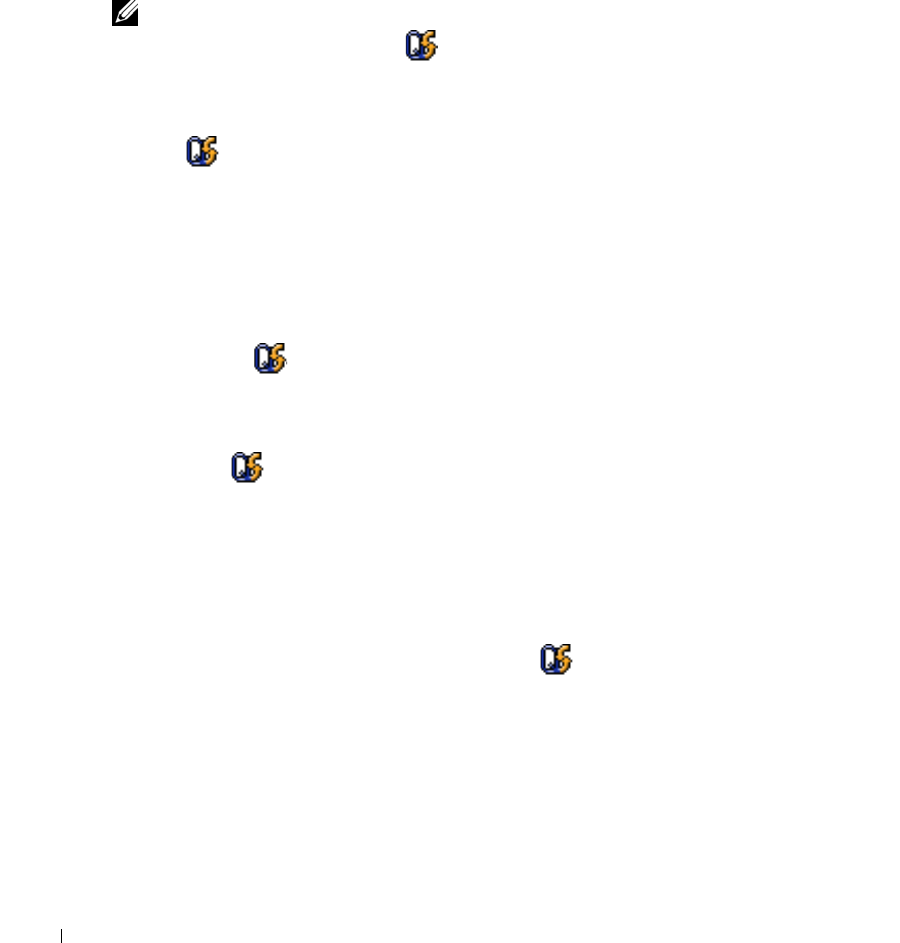
44 Power Management
www.dell.com | support.dell.com
Hibernate Tab
The Hibernate tab lets you enable hibernate mode by clicking the Enable hibernation check
box.
Dell™ QuickSet Features
NOTE: This feature may not be available on your computer.
Dell QuickSet is activated from the icon on the taskbar and functions differently when you
click, double-click, or right-click the icon.
Clicking the QuickSet Icon
Click the icon to perform the following tasks:
• Adjust power management settings using the Power Management Wizard (see page 39).
• Adjust the size of icons and toolbars.
• Select a power scheme that you set in the Power Management Wizard (see page 39).
• Turn presentation mode on or off.
Double-Clicking the QuickSet Icon
Double-click the icon to adjust power management settings using the Power Management
Wizard (see page 39).
Right-Clicking the QuickSet Icon
Right-click the icon to perform the following tasks:
• Enable or disable the Brightness Meter on the screen (see page 33).
• Enable or disable the Volume Meter on the screen (see page 51).
• Turn the wireless activity indicator on or off (see page 40).
•View
Dell QuickSet Help
.
• View the version and copyright date of the QuickSet program installed on your computer.
For more information about QuickSet, right-click the icon in the taskbar and click
Help
.
book.book Page 44 Wednesday, September 28, 2005 2:16 PM

Using a Battery 45
6
Using a Battery
Battery Types
See "Specifications" on page 131 for information on supported batteries.
Battery Performance
CAUTION: Before you begin any of the procedures in this section, follow the safety instructions in the
Product Information Guide
.
NOTE: For information about the Dell warranty for your computer, see the Product Information Guide or
separate paper warranty document that shipped with your computer.
For optimal computer performance and to help preserve BIOS settings, operate your Dell™
portable computer with the main battery installed at all times. Use a battery to run the
computer when it is not connected to an electrical outlet. One battery is supplied as standard
equipment in the battery bay.
NOTE: Because the battery may not be fully charged, use the AC adapter to connect your new computer
to an electrical outlet the first time you use the computer. For best results, operate the computer with the
AC adapter until the battery is fully charged. To view battery charge status, access the Control Panel→
Power Options→ Power Meter tab.
Battery operating time varies depending on operating conditions.
NOTE: Battery operating time (the time the battery can hold a charge) decreases over time. Depending
on how often the battery is used and the conditions under which it is used, you may need to purchase a
new battery during the life of your computer.
Operating time is significantly reduced when you perform operations including, but not limited
to, the following:
•Using optical drives
• Using wireless communications devices, ExpressCards, or USB devices
• Using high-brightness display settings, 3D screen savers, or other power-intensive programs
such as 3D games
• Running the computer in maximum performance mode (see page 40)
NOTE: It is recommended that you connect your computer to an electrical outlet when writing to a CD
or DVD.
book.book Page 45 Wednesday, September 28, 2005 2:16 PM
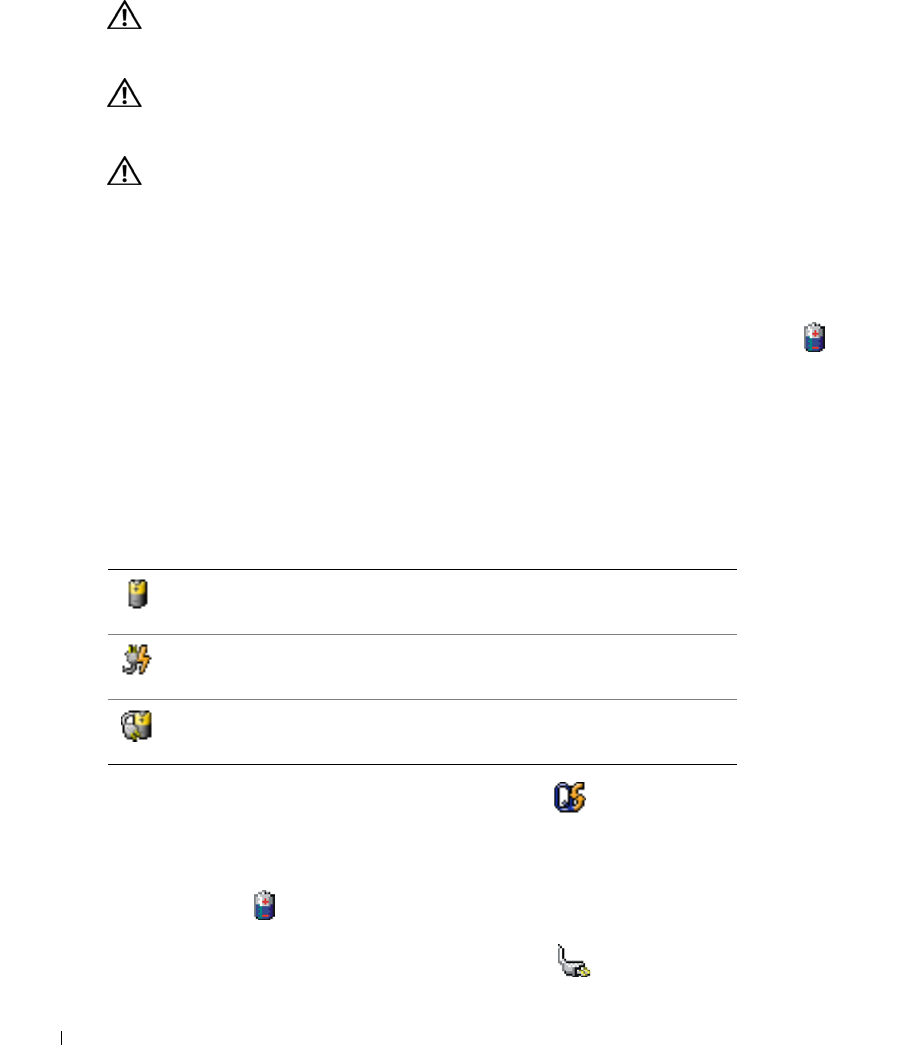
46 Using a Battery
www.dell.com | support.dell.com
You can
check the battery charge
before you
insert the battery
into the computer. You can also set
power management options to alert you when the
battery charge is low
.
CAUTION: Using an incompatible battery may increase the risk of fire or explosion. Replace the
battery only with a compatible battery purchased from Dell. The battery is designed to work with your
Dell computer. Do not use a battery from other computers with your computer.
CAUTION: Do not dispose of batteries with household waste. When your battery no longer holds a
charge, call your local waste disposal or environmental agency for advice on disposing of a battery.
See "Battery Disposal" in the
Product Information Guide
.
CAUTION: Misuse of the battery may increase the risk of fire or chemical burn. Do not puncture,
incinerate, disassemble, or expose the battery to temperatures above 60°C (140°F). Keep the battery
away from children. Handle damaged or leaking batteries with extreme care. Damaged batteries may
leak and cause personal injury or equipment damage.
Checking the Battery Charge
The Dell QuickSet Battery Meter, the Microsoft Windows Power Meter window and icon,
the battery charge gauge, and the low-battery warning provide information on the battery charge.
Dell™ QuickSet Battery Meter
If Dell QuickSet is installed, press <Fn><F3> to display the QuickSet Battery Meter.
The Battery Meter window displays status, charge level, and charge completion time for the
battery in your computer.
The following icons appear in the Battery Meter window:
For more information about QuickSet, right-click the icon in the taskbar, and click Help.
Microsoft® Windows® Power Meter
The Windows Power Meter indicates the remaining battery charge. To check the Power Meter,
double-click the icon on the taskbar. For more information about the Power Meter tab, see
"Power Management" on page 39.
If the computer is connected to an electrical outlet, a icon appears.
The computer is running on battery power.
The computer is connected to AC power and the battery is charging.
The computer is connected to AC power and the battery is fully charged.
book.book Page 46 Wednesday, September 28, 2005 2:16 PM

Using a Battery 47
Charge Gauge
Before you
insert a battery
, press the status button on the battery charge gauge to illuminate the
charge-level lights. Each light represents approximately 20 percent of the total battery charge.
For example, if the battery has 80 percent of its charge remaining, four of the lights are on. If no
lights appear, the battery has no charge.
Health Gauge
The battery operating time is largely determined by the number of times it is charged. After
hundreds of charge and discharge cycles, batteries lose some charge capacity, or battery health.
To check the battery health, press and hold the status button on the battery charge gauge for at
least 3 seconds. If no lights appear, the battery is in good condition, and more than 80 percent of
its original charge capacity remains. Each light represents incremental degradation. If five lights
appear, less than 60 percent of the charge capacity remains, and you should consider replacing
the battery. See "Specifications" on page 131 for more information about the battery operating
time.
Low-Battery Warning
NOTICE: To avoid losing or corrupting data, save your work immediately after a low-battery warning.
Then connect the computer to an electrical outlet. If the battery runs completely out of power, hibernate
mode begins automatically.
A pop-up window warns you when the battery charge is approximately 90 percent depleted. For
more information about low-battery alarms, see "Power Management" on page 39.
Charging the Battery
NOTE: Without Dell™ ExpressCharge™, the AC adapter charges a completely discharged 6-cell battery
in approximately 2 hours and a 9-cell battery in approximately 3 hours with the computer turned off.
Charge time is longer with the computer turned on. You can leave the battery in the computer as long as
you like. The battery’s internal circuitry prevents the battery from overcharging.
When you connect the computer to an electrical outlet or install a battery while the computer is
connected to an electrical outlet, the computer checks the battery charge and temperature. If
necessary, the AC adapter then charges the battery and maintains the battery charge.
If the battery is hot from being used in your computer or being in a hot environment, the
battery may not charge when you connect the computer to an electrical outlet.
The battery is too hot to start charging if the light flashes alternately green and orange.
Disconnect the computer from the electrical outlet and allow the computer and the battery to
cool to room temperature. Then connect the computer to an electrical outlet to continue
charging the battery.
For more information about resolving problems with a battery, see "Power Problems" on page 91.
book.book Page 47 Wednesday, September 28, 2005 2:16 PM

48 Using a Battery
www.dell.com | support.dell.com
Storing a Battery
Remove the battery when you store your computer for an extended period of time. A battery
discharges during prolonged storage. After a long storage period,
recharge the battery
fully before
you use it.
book.book Page 48 Wednesday, September 28, 2005 2:16 PM
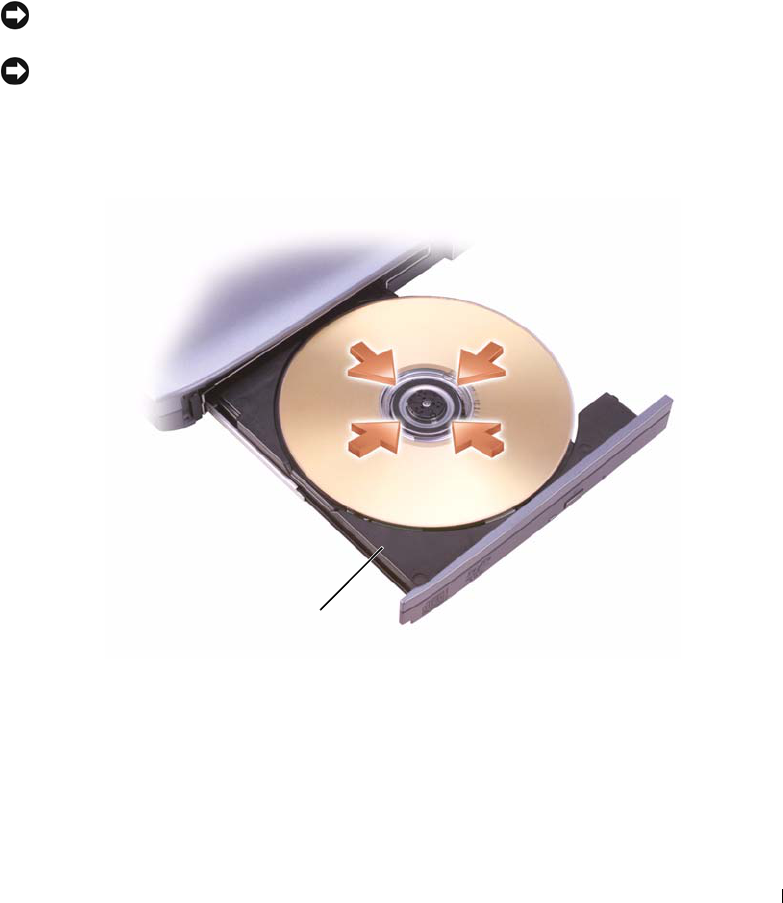
Using CDs, DVDs, and Other Multimedia 49
7
Using CDs, DVDs, and Other Multimedia
Playing a CD or DVD
NOTICE: Do not press down on the CD or DVD tray when you open or close it. Keep the tray closed when
you are not using the drive.
NOTICE: Do not move the computer when you are playing CDs or DVDs to prevent damage to your
CD/DVD drive or discs.
1
Press the eject button on the front of the drive.
2
Pull out the tray.
3
Place the disc, label side up, in the center of the tray and snap the disc onto the spindle.
1CD/DVD tray
1
book.book Page 49 Wednesday, September 28, 2005 2:16 PM

50 Using CDs, DVDs, and Other Multimedia
www.dell.com | support.dell.com
NOTE: If you use a CD/DVD drive that shipped with another computer, you need to install the drivers and
software necessary to play CDs or DVDs or write data. For more information, see the Drivers and Utilities
CD (the Drivers and Utilities CD is optional and may not be available for your computer or in certain
countries).
4
Push the tray back into the drive.
To format CDs for storing data, to create music CDs, or to copy CDs, see the CD software that
came with your computer.
NOTE: Ensure that you follow all copyright laws when you create CDs.
The CD player includes the following basic buttons:
The DVD player includes the following basic buttons:
Play.
Move backward within the current track.
Move forward within the current track.
Go to the previous track.
Go to the next track.
Pause.
Stop.
Eject.
Play.
Stop.
Restart the current chapter.
Fast forward.
Fast reverse.
Go to the next title or chapter.
Go to the previous title or chapter.
Continuously play the current title or chapter.
book.book Page 50 Wednesday, September 28, 2005 2:16 PM
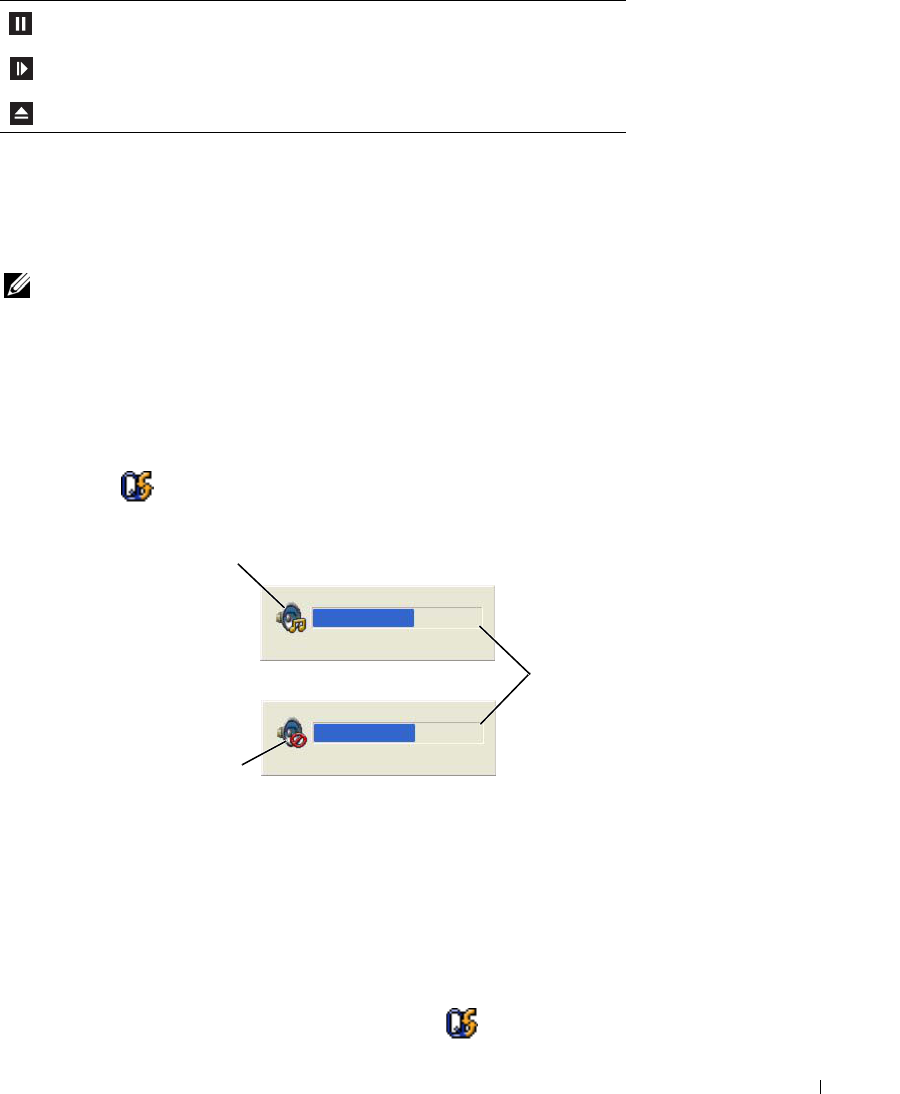
Using CDs, DVDs, and Other Multimedia 51
For more information on playing CDs or DVDs, click Help in the CD or DVD player program
window (if available).
Adjusting the Volume
NOTE: When the speakers are muted, you do not hear the CD or DVD playing.
1
Click the
Start
button, point to
All Programs
→
Accessories
→
Entertainment
, and then click
Volume Control
.
2
In the
Volume Control
window, click and drag the bar in the
Volume Control
column and
slide it up or down to increase or decrease the volume.
For more information on volume control options, click Help in the Volume Control window.
The Volume Meter displays the current volume level, including mute, on your computer. Either
right-click the icon in the taskbar or press the volume control buttons to enable or disable
the Volume Meter on the screen.
When the Volume Meter is enabled, adjust the volume with the volume control buttons or by
pressing the following key combinations:
•Press
<Fn><PageUp> to increase the volume.
•Press
<Fn><PageDn>
to decrease the volume.
•Press
<Fn><End> to mute the volume.
For more information about QuickSet, right-click the icon in the taskbar and click Help.
Pause.
Advance a single frame while in pause mode.
Eject.
1volume icon 2Volume Meter 3mute icon
1
3
2
book.book Page 51 Wednesday, September 28, 2005 2:16 PM

52 Using CDs, DVDs, and Other Multimedia
www.dell.com | support.dell.com
Adjusting the Picture
If an error message notifies you that the current resolution and color depth are using too much
memory and preventing DVD playback, adjust the display properties.
1
Click the
Start
button and click
Control Panel
.
2
Under
Pick a category
, click
Appearance and Themes
.
3
Under
Pick a task...
, click
Change the screen resolution
.
4
In the
Display Properties
window, click and drag the bar in
Screen resolution
to reduce the
screen resolution setting.
5
Click the drop-down menu under
Color quality
, and then click
Medium (16 bit)
.
6
Click
OK
to save the settings and close the window.
Copying CDs and DVDs
NOTE: Ensure that you observe all copyright laws when creating CDs or DVDs.
This section applies only to computers that have a CD-RW, DVD+/-RW, or CD-RW/DVD
(combo) drive.
NOTE: The types of CD or DVD drives offered by Dell may vary by country.
The following instructions explain how to make an exact copy of a CD or DVD. You can also use
Sonic DigitalMedia for other purposes, such as creating music CDs from audio files stored on
your computer or backing up important data. For help, open Sonic DigitalMedia and then click
the question mark icon in the upper-right corner of the window.
How to Copy a CD or DVD
NOTE: CD-RW/DVD combo drives cannot write to DVD media. If you have a CD-RW/DVD combo drive
and you experience recording problems, check for available software patches on the Sonic support
website at www.sonic.com.
The DVD-writable drives installed in Dell™ computers can write to and read DVD+/-R,
DVD+/-RW and DVD+R DL (dual layer) media, but they cannot write to and may not read
DVD-RAM or DVD-R DL media.
NOTE: Most commercial DVDs have copyright protection and cannot be copied using Sonic
DigitalMedia.
1
Click the
Start
button, point to
All Programs
→
Sonic
→
DigitalMedia Projects
, and then
click
Copy
.
2
Under the
Copy
tab, click
Disc Copy
.
book.book Page 52 Wednesday, September 28, 2005 2:16 PM

Using CDs, DVDs, and Other Multimedia 53
3
To copy the CD or DVD:
•
If you have one CD or DVD drive
, ensure that the settings are correct and click the
Disc
Copy
button. The computer reads your source CD or DVD and copies the data to a
temporary folder on your computer hard drive.
When prompted, insert a blank CD or DVD into the drive and click
OK
.
•
If you have two CD or DVD drives
, select the drive into which you have inserted your
source CD or DVD and click the
Disc
Copy
button. The computer copies the data from
the source CD or DVD to the blank CD or DVD.
Once you have finished copying the source CD or DVD, the CD or DVD that you have
created automatically ejects.
Using Blank CDs and DVDs
CD-RW drives can write to CD recording media only (including high-speed CD-RW) while
DVD-writable drives can write to both CD and DVD recording media.
Use blank CD-Rs to record music or permanently store data files. After creating a CD-R, you
cannot write to that CD-R again (see the Sonic documentation for more information). Use
blank CD-RWs to write to CDs or to erase, rewrite, or update data on CDs.
Blank DVD+/-Rs can be used to permanently store large amounts of information. After you
create a DVD+/-R disc, you may not be able to write to that disc again if the disc is "finalized" or
"closed" during the final stage of the disc creation process. Use blank DVD+/-RWs if you plan
to erase, rewrite, or update information on that disc later.
CD-Writable Drives
DVD-Writable Drives
Media Type Read Write Rewritable
CD-R Yes Yes No
CD-RW Yes Yes Yes
Media Type Read Write Rewritable
CD-R Yes Yes No
CD-RW Yes Yes Yes
DVD+R Yes Yes No
DVD-R Yes Yes No
DVD+RW Yes Yes Yes
DVD-RW Yes Yes Yes
DVD+R DL Yes Yes No
book.book Page 53 Wednesday, September 28, 2005 2:16 PM

54 Using CDs, DVDs, and Other Multimedia
www.dell.com | support.dell.com
Helpful Tips
• Use Microsoft
®
Windows
®
Explorer to drag and drop files to a CD-R or CD-RW only after
you start Sonic DigitalMedia and open a DigitalMedia project.
• Use CD-Rs to burn music CDs that you want to play in regular stereos. CD-RWs do not play
in most home or car stereos.
• You cannot create audio DVDs with Sonic DigitalMedia.
• Music MP3 files can be played only on MP3 players or on computers that have MP3 software
installed.
• Commercially available DVD players used in home theater systems may not support all
available DVD formats. For a list of formats supported by your DVD player, see the
documentation provided with your DVD player or contact the manufacturer.
• Do not burn a blank CD-R or CD-RW to its maximum capacity; for example, do not copy a
650-MB file to a blank 650-MB CD. The CD-RW drive needs 1–2 MB of the blank space to
finalize the recording.
• Use a blank CD-RW to practice CD recording until you are familiar with CD recording
techniques. If you make a mistake, you can erase the data on the CD-RW and try again. You
can also use blank CD-RWs to test music file projects before you record the project
permanently to a blank CD-R.
See the Sonic website at www.sonic.com for additional information.
Using Dell MediaDirect
NOTE: Dell QuickSet, which is automatically installed and enabled on your computer, is necessary for
Dell MediaDirect to function. Changing or disabling QuickSet default settings can limit Dell MediaDirect
functionality. For more information about Dell QuickSet, see "Dell™ QuickSet Features" on page 44.
If you have Microsoft Windows Media Center Edition or another version of Windows XP with
Dell Media Experience installed, you can press the Dell MediaDirect button to launch
either media program.
• If you press the Dell MediaDirect button while you are logged in, either Windows XP Media
Center Manager or Dell Media Experience launches, depending on your system setup. If both
programs are present, Windows XP Media Center Manager will launch.
• When your computer is off, you can press the Dell MediaDirect button to start the computer
and automatically launch the media application. The computer can either be on and running
Windows or it can be in the hibernate, standby, or off mode.
DVD-R DL Maybe No No
DVD-RAM Maybe No No
Media Type Read Write Rewritable
book.book Page 54 Wednesday, September 28, 2005 2:16 PM
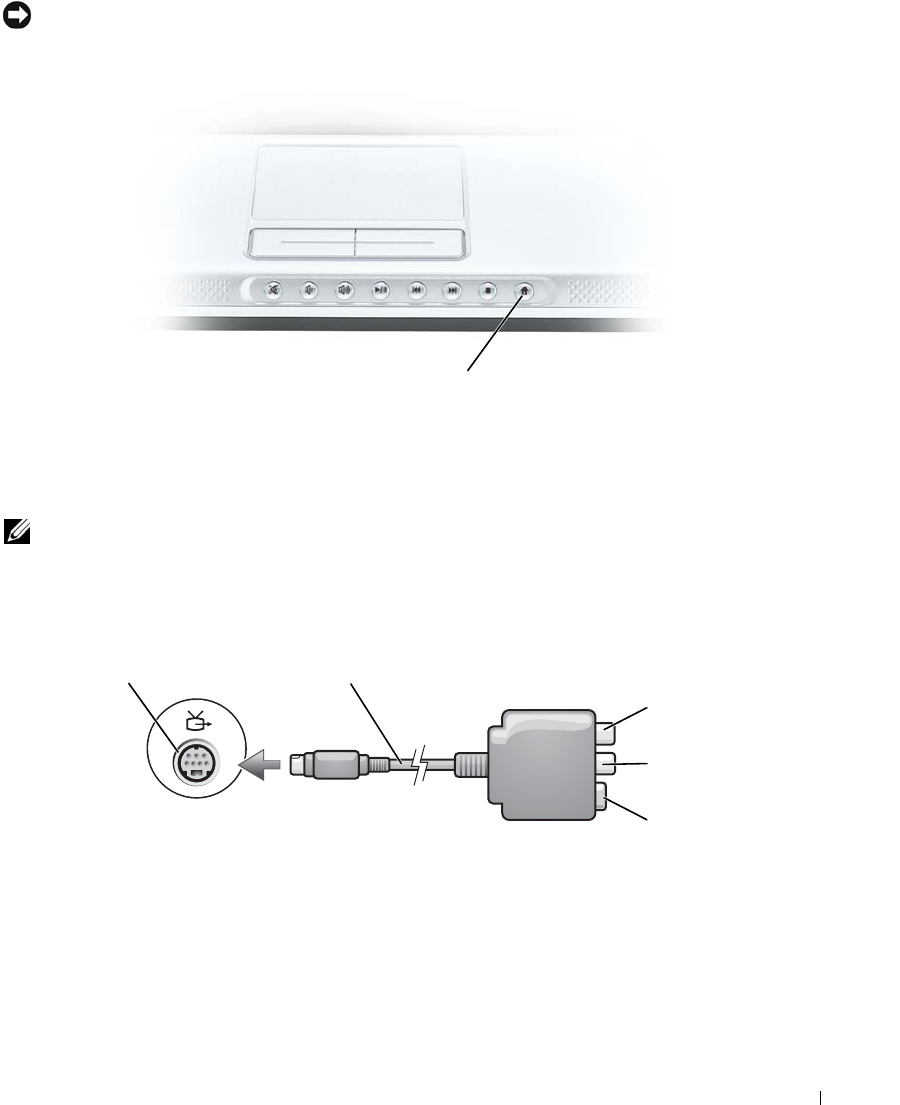
Using CDs, DVDs, and Other Multimedia 55
NOTICE: You cannot reinstall the Dell MediaDirect feature if you voluntarily reformat the hard drive.
Contact Dell for assistance. See "Contacting Dell" on page 145.
Connecting Your Computer to a TV or Audio Device
NOTE: Video and audio cables for connecting your computer to a TV or other audio device are not
included with your computer. Cables may be purchased at most consumer electronics stores. The
TV/digital audio adapter cable is available for purchase from Dell.
Your computer has an S-video TV-out connector that, together with a standard S-video cable
(available from Dell), enables you to connect the computer to a TV.
1Dell MediaDirect button
1S-video TV-out connector 3S/PDIF digital audio
connector
5S-video connector
2TV/digital audio adapter
cable
4composite video-output
connector
1
5
4
3
12
book.book Page 55 Wednesday, September 28, 2005 2:16 PM
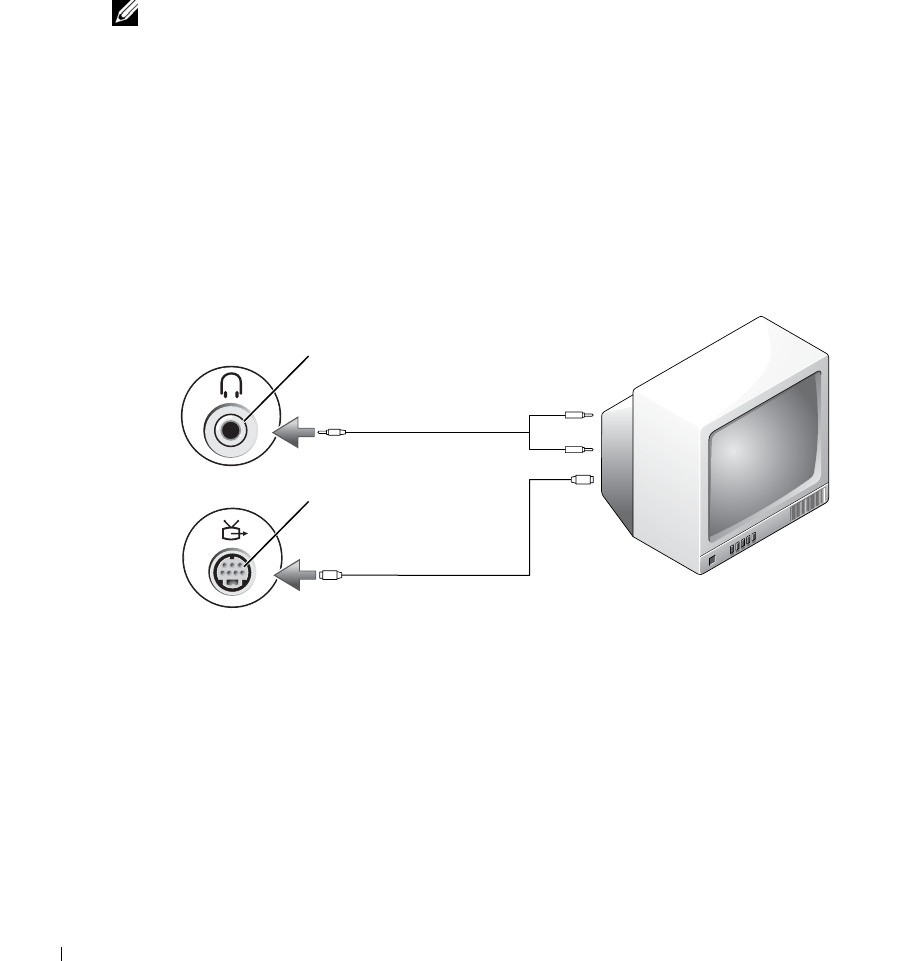
56 Using CDs, DVDs, and Other Multimedia
www.dell.com | support.dell.com
Your TV has either an S-video input connector or a composite video-input connector.
Depending on what type of connector is available on your TV, you can use a commercially
available S-video cable or composite video cable to connect your computer to your TV.
It is recommended that you connect video and audio cables to your computer in one of the
following combinations.
NOTE: See the diagrams at the beginning of each subsection to help you determine which method of
connection you should use.
• S-video and standard audio
• Composite video and standard audio
When you finish connecting the video and audio cables between your computer and your TV,
you must enable your computer to work with the TV. See "Enabling the Display Settings for a
TV" on page 66 to ensure that the computer recognizes and works properly with the TV.
Additionally, if you are using S/PDIF digital audio, see "Enabling S/PDIF Digital Audio" on
page 64.
S-Video and Standard Audio
1audio connector 2S-video TV-out connector
1
2
book.book Page 56 Wednesday, September 28, 2005 2:16 PM
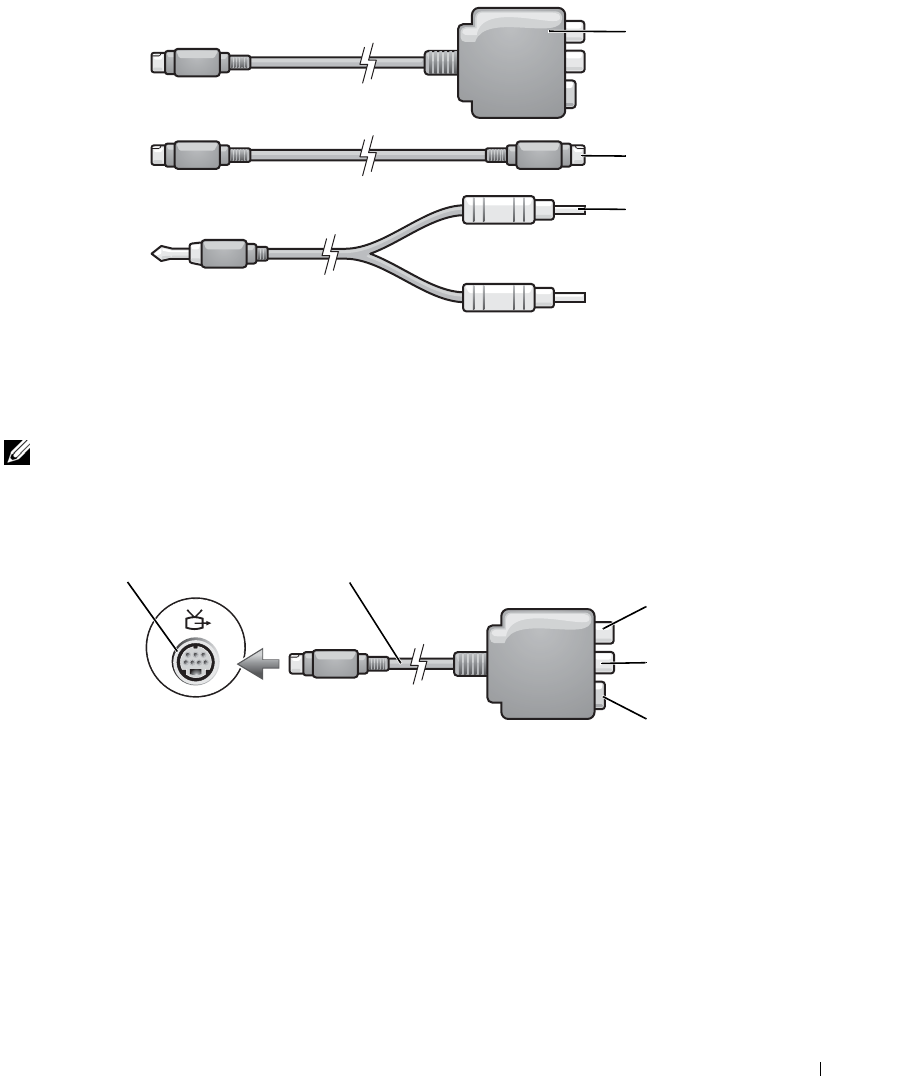
Using CDs, DVDs, and Other Multimedia 57
1
Turn off the computer and the TV and/or audio device that you want to connect.
NOTE: You can connect an S-video cable directly to the S-video TV-out connector on the computer
(without the TV/digital audio adapter cable) if your TV or audio device supports S-video but not S/PDIF
digital audio.
2
Plug one end of the S-video cable in to the S-video output connector on the computer.
3
Plug the other end of the S-video cable in to the S-video input connector on your TV.
4
Plug the single-connector end of the audio cable in to the headphone connector on your
computer.
5
Plug the two RCA connectors on the other end of the audio cable in to the audio input
connectors on your TV or other audio device.
1TV/digital audio adapter
cable
2standard S-video cable 3standard audio cable
1S-video TV-out connector 3S/PDIF digital audio
connector
5S-video connector
2TV/digital audio adapter
cable
4composite video-output
connector
1
2
3
5
4
3
12
book.book Page 57 Wednesday, September 28, 2005 2:16 PM
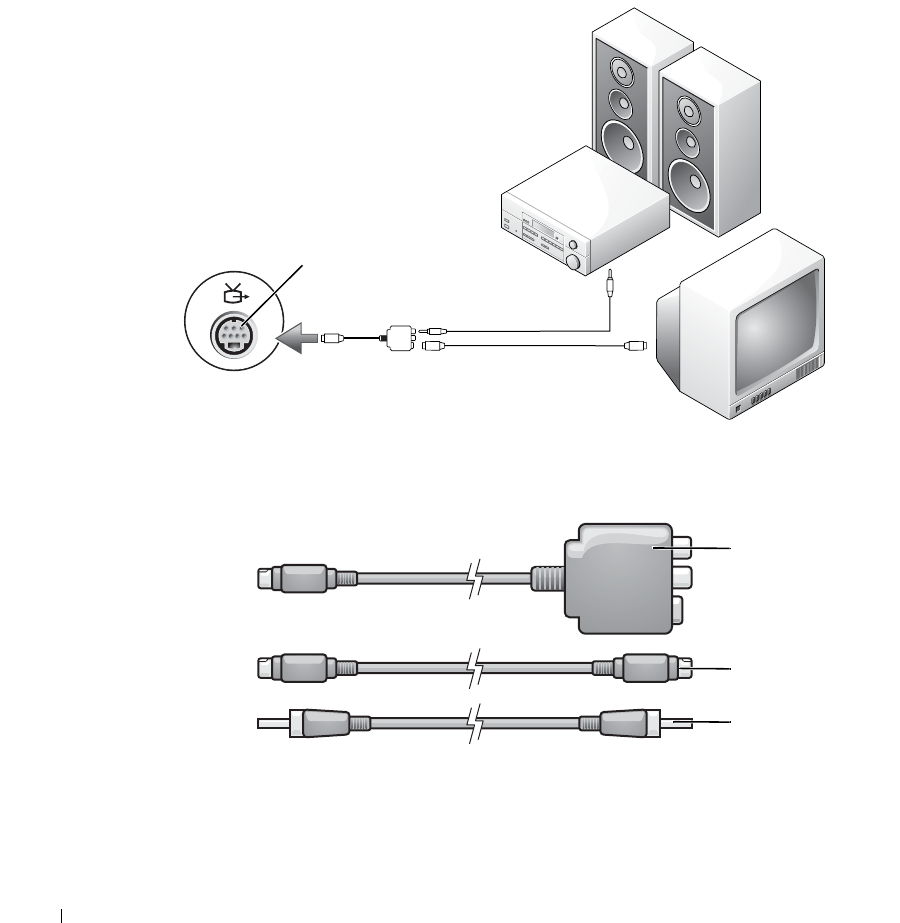
58 Using CDs, DVDs, and Other Multimedia
www.dell.com | support.dell.com
6
Turn on the TV and any audio device that you connected (if applicable), and then turn on the
computer.
7
See "Enabling the Display Settings for a TV" on page 66 to ensure that the computer
recognizes and works properly with the TV.
S-Video and S/PDIF Digital Audio
1S-video TV-out connector
1TV/digital audio adapter
cable
2S-video cable 3S/PDIF digital audio cable
1
1
2
3
book.book Page 58 Wednesday, September 28, 2005 2:16 PM
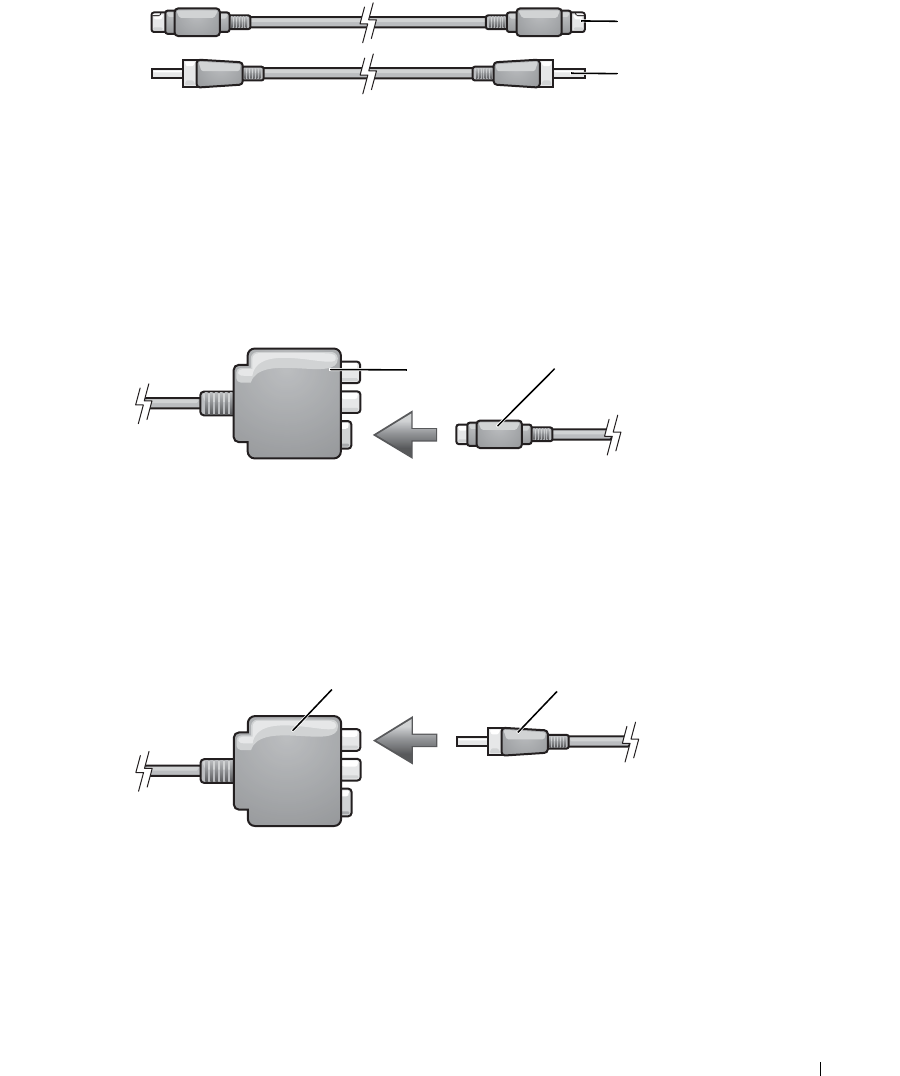
Using CDs, DVDs, and Other Multimedia 59
1
Turn off the computer and the TV and/or audio device that you want to connect.
2
Connect the TV/digital audio adapter cable to the S-video TV-out connector on your
computer.
3
Plug one end of the S-video cable in to the S-video input connector on the TV/digital audio
adapter cable.
4
Plug the other end of the S-video cable in to the S-video input connector on the TV.
5
Plug one end of the S/PDIF digital audio cable in to the digital audio connector on the
TV/digital audio adapter cable.
6
Plug the other end of the S/PDIF digital audio cable in to the audio input connector on your
TV or other audio device.
1S-video cable 2S/PDIF digital audio cable
1TV/digital audio adapter
cable
2S-video cable
1TV/digital audio adapter
cable
2S/PDIF digital audio cable
1
2
12
1 2
book.book Page 59 Wednesday, September 28, 2005 2:16 PM
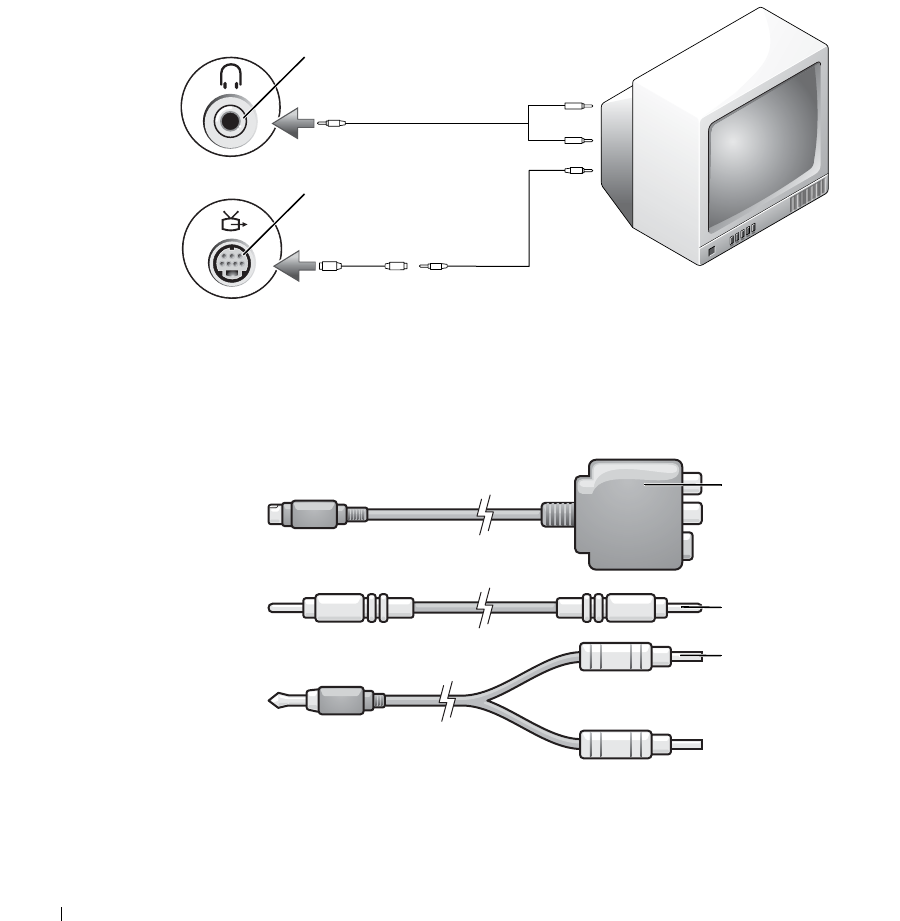
60 Using CDs, DVDs, and Other Multimedia
www.dell.com | support.dell.com
7
Turn on the TV, turn on any audio device that you connected (if applicable), and then turn on
the computer.
8
See "Enabling the Display Settings for a TV" on page 66 to ensure that the computer
recognizes and works properly with the TV.
Composite Video and Standard Audio
1audio input connector 2composite video-input
connector
1TV/digital audio adapter
cable
2composite video cable 3standard audio cable
2
1
1
2
3
book.book Page 60 Wednesday, September 28, 2005 2:16 PM
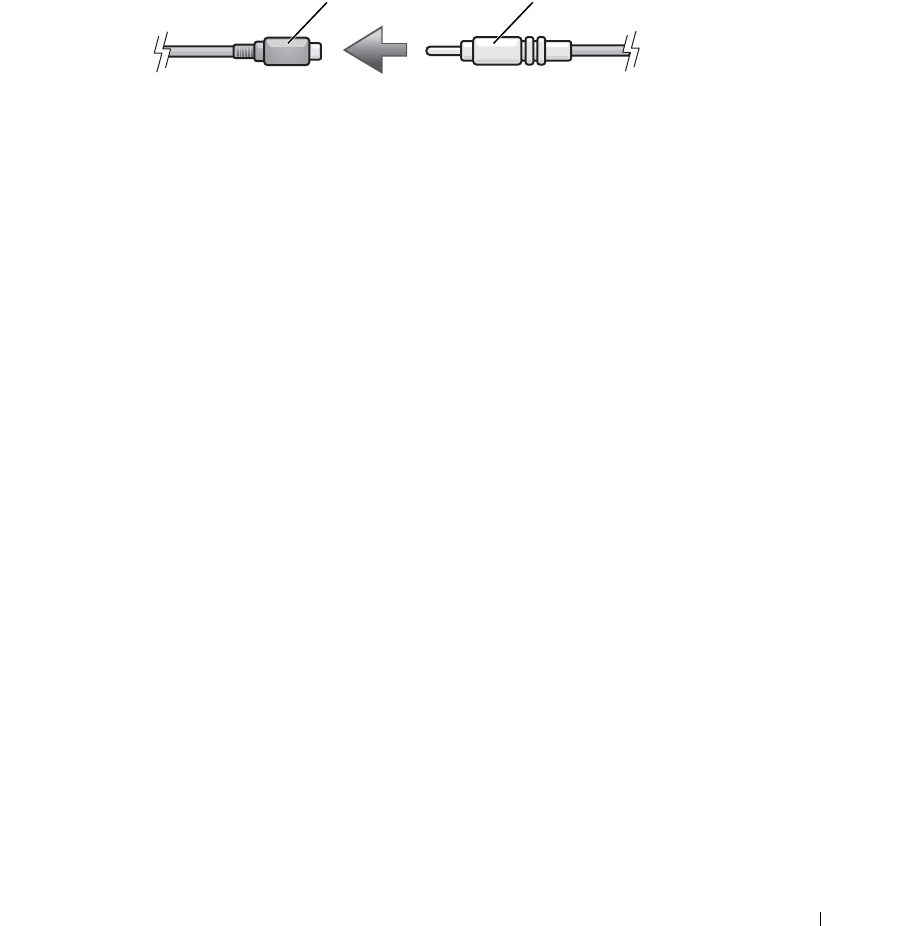
Using CDs, DVDs, and Other Multimedia 61
1
Turn off the computer and the TV and/or audio device that you want to connect.
2
Connect the standard video to composite video adapter cable to the S-video TV-out
connector on the computer.
3
Plug one end of the composite video cable in to the composite video-input connector on the
standard video to composite video cable.
4
Plug the other end of the composite video cable in to the composite video-input connector on
the TV.
5
Plug the single-connector end of the audio cable in to the headphone connector on the
computer.
6
Plug the two RCA connectors on the other end of the audio cable in to the audio input
connectors on your TV or other audio device.
7
Turn on the TV, turn on any audio device that you connected (if applicable), and then turn on
the computer.
8
See "Enabling the Display Settings for a TV" on page 66 to ensure that the computer
recognizes and works properly with the TV.
1standard S-video to
composite video adapter
2composite video cable
21
book.book Page 61 Wednesday, September 28, 2005 2:16 PM
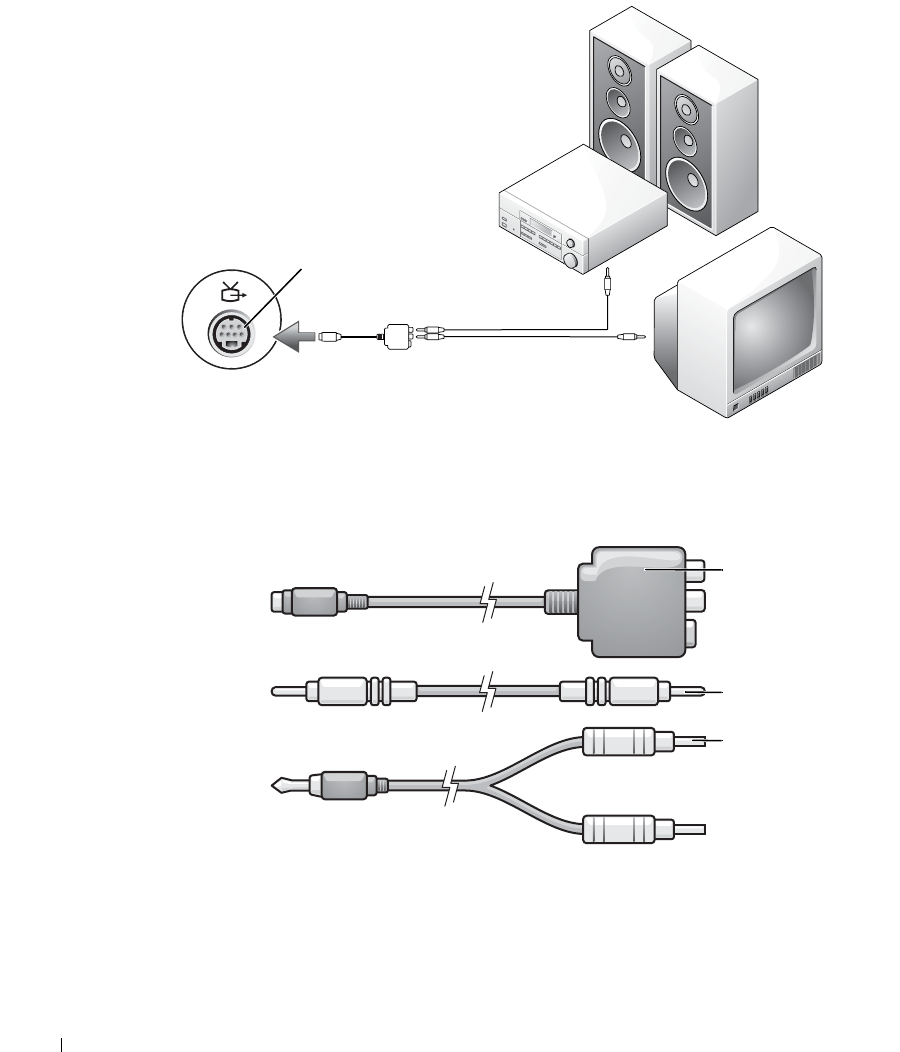
62 Using CDs, DVDs, and Other Multimedia
www.dell.com | support.dell.com
Composite Video and S/PDIF Digital Audio
1composite video-input
connector
1TV/digital audio adapter
cable
2composite video cable 3standard audio cable
1
1
2
3
book.book Page 62 Wednesday, September 28, 2005 2:16 PM
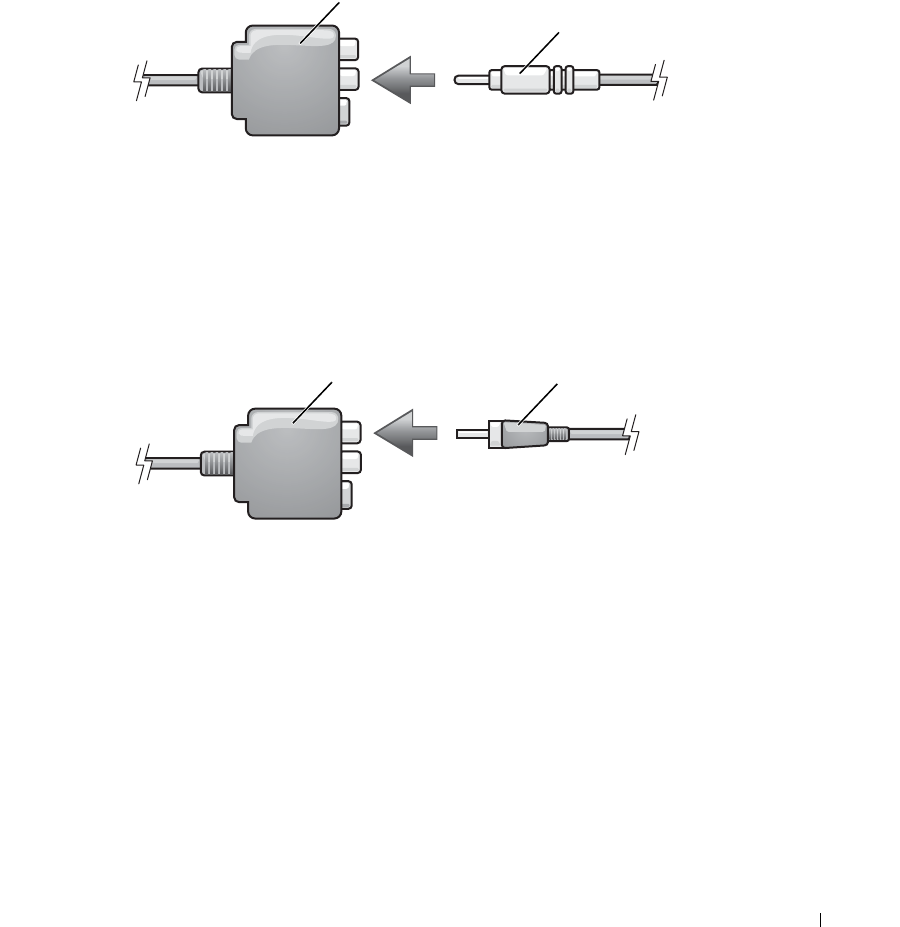
Using CDs, DVDs, and Other Multimedia 63
1
Turn off the computer and the TV and/or audio device that you want to connect.
2
Connect the TV/digital audio adapter cable to the S-video TV-out connector on the
computer.
3
Plug one end of the composite video cable in to the composite video-input connector on the
TV/digital audio adapter cable.
4
Plug the other end of the composite video cable in to the composite video-input connector on
the TV.
5
Plug one end of the S/PDIF digital audio cable in to the S/PDIF audio connector on the
TV/digital audio adapter cable.
6
Plug the other end of the digital audio cable in to the S/PDIF input connector on your TV or
other audio device.
7
Turn on the TV, turn on any audio device that you connected (if applicable), and then turn on
the computer.
8
See "Enabling the Display Settings for a TV" on page 66 to ensure that the computer
recognizes and works properly with the TV.
1TV/digital audio adapter
cable
2composite video-input
connector
1TV/digital audio adapter
cable
2S/PDIF digital audio cable
2
1
1 2
book.book Page 63 Wednesday, September 28, 2005 2:16 PM
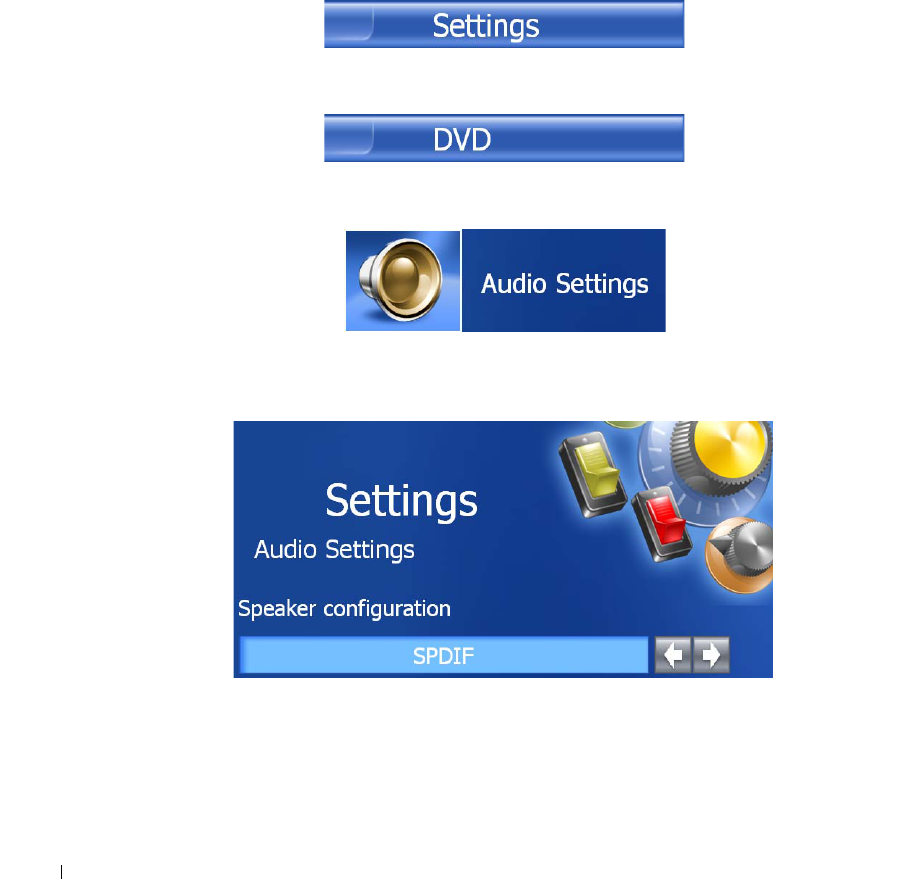
64 Using CDs, DVDs, and Other Multimedia
www.dell.com | support.dell.com
Enabling S/PDIF Digital Audio
If your computer has a DVD drive, you can enable digital audio for DVD playback.
1
Click
Start
→
Programs
→
PowerDVD
to launch the
Cyberlink PowerDVD
application.
2
Insert a DVD into the DVD drive.
If the DVD begins playing, click the stop button.
3
Click the
Settings
option.
4
Click the
DVD
option.
5
Click the
DVD Audio Setting
icon.
6
Click the arrows beside the
Speaker Configuration
setting to scroll through the options, and
select the
SPDIF
option.
7
Click the
Back
button once, and then click the
Back
button again to return to the main menu
screen.
book.book Page 64 Wednesday, September 28, 2005 2:16 PM
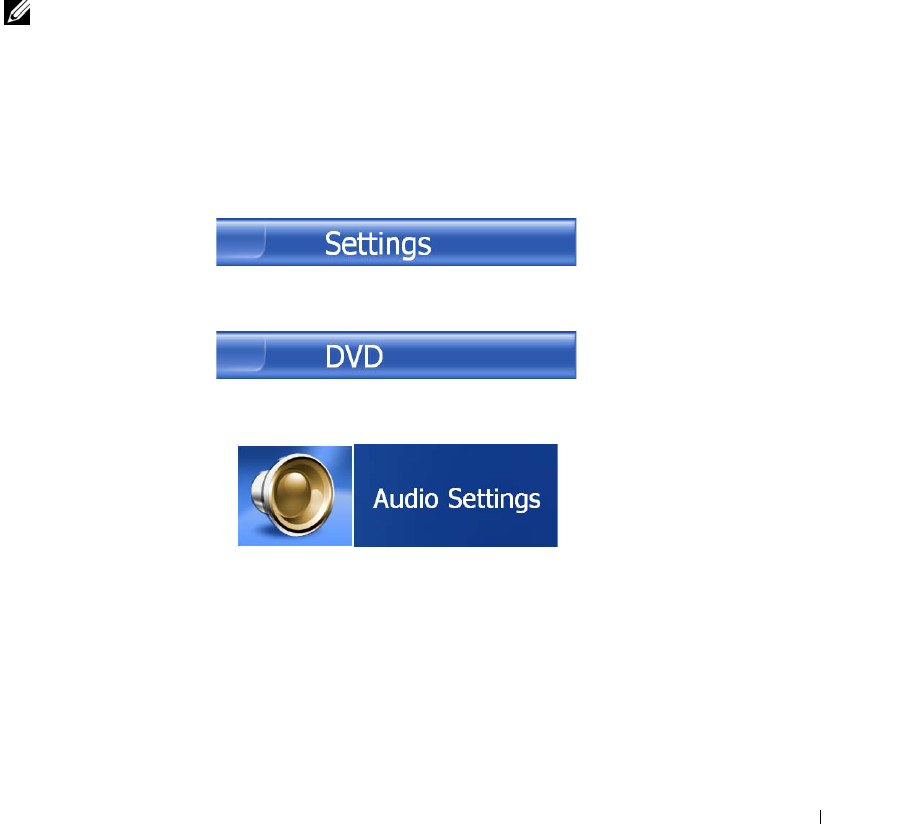
Using CDs, DVDs, and Other Multimedia 65
Enabling S/PDIF in the Windows Audio Driver
1
Double-click the speaker icon in the Windows notification area.
2
Click the
Options
menu and then click
Advanced Controls
.
3
Click
Advanced
.
4
Click
S/PDIF Interface
.
5
Click
Close
.
6
Click
OK
.
Setting Up the Cyberlink (CL) Headphones
NOTE: The CL headphone feature is available only if your computer has a DVD drive.
If your computer has a DVD drive, you can enable digital audio for DVD playback.
1
Click
Start
→
Programs
→
PowerDVD
to launch the
Cyberlink PowerDVD
program.
2
Insert a DVD into the DVD drive.
If the DVD begins playing, click the stop button.
3
Click the
Settings
option.
4
Click the
DVD
option.
5
Click the
DVD Audio Setting
icon.
6
Click the arrows beside the
Speaker Configuration
setting to scroll through the options, and
select the
Headphones
option.
7
Click the arrows beside the
Audio listening mode
setting to scroll through the options, and
select the
CL Headphone
option.
8
Click the arrows beside the
Dynamic range compression
option to select the most suitable
option.
book.book Page 65 Wednesday, September 28, 2005 2:16 PM
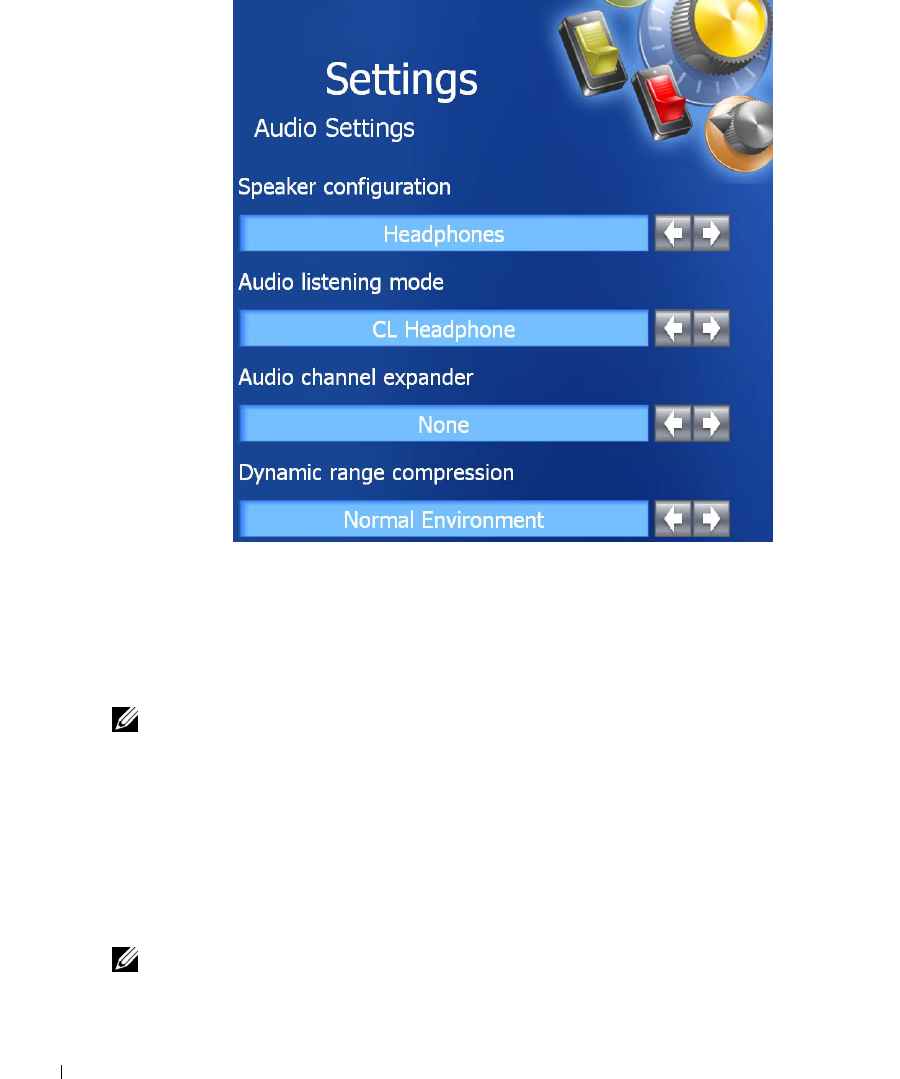
66 Using CDs, DVDs, and Other Multimedia
www.dell.com | support.dell.com
9
Click the
Back
button once, and then click the
Back
button again to return to the main menu
screen.
Enabling the Display Settings for a TV
Video Controller
NOTE: To ensure that the display options appear correctly, connect the TV to the computer before you
enable the display settings.
1
Click the
Start
button, point to
Settings
, and then click
Control Panel
.
2
Double-click
Display
and click the
Settings
tab.
3
Click
Advanced
.
4
Click the tab for your video card.
5
In the display devices section, select the appropriate option for using either a single display or
multiple displays, ensuring that the display settings are correct for your selection.
NOTE: To determine the type of video card installed in your computer, click the Start button and click
Help and Support. Under Pick a Task, click Use Tools to view your computer information and diagnose
problems and click My Computer Information.
book.book Page 66 Wednesday, September 28, 2005 2:16 PM

Using ExpressCards 67
8
Using ExpressCards
ExpressCard Types
See "Specifications" on page 131 for information on supported ExpressCards.
NOTE: An ExpressCard is not a bootable device.
ExpressCard Blanks
Your computer shipped with a plastic blank installed in the ExpressCard slot. Blanks protect
unused slots from dust and other particles. Save the blank for use when no ExpressCard is
installed in the slot; blanks from other computers may not fit your computer.
To remove the blank, see "Removing an ExpressCard or Blank" on page 68.
Installing an ExpressCard
You can install an ExpressCard in the computer while the computer is running. The computer
automatically detects the card.
ExpressCards are generally marked with a symbol (such as a triangle or an arrow) or a label to
indicate which end to insert into the slot. The cards are keyed to prevent incorrect insertion. If
card orientation is not clear, see the documentation that came with the card.
CAUTION: Before you begin any of the procedures in this section, follow the safety instructions in the
Product Information Guide
.
To install an ExpressCard:
1
Hold the card with the top side of the card facing up. The latch may need to be in the "in"
position before you insert the card.
2
Slide the card into the slot until the card is completely seated in its connector.
If you encounter too much resistance, do not force the card. Check the card orientation and
try again.
book.book Page 67 Wednesday, September 28, 2005 2:16 PM
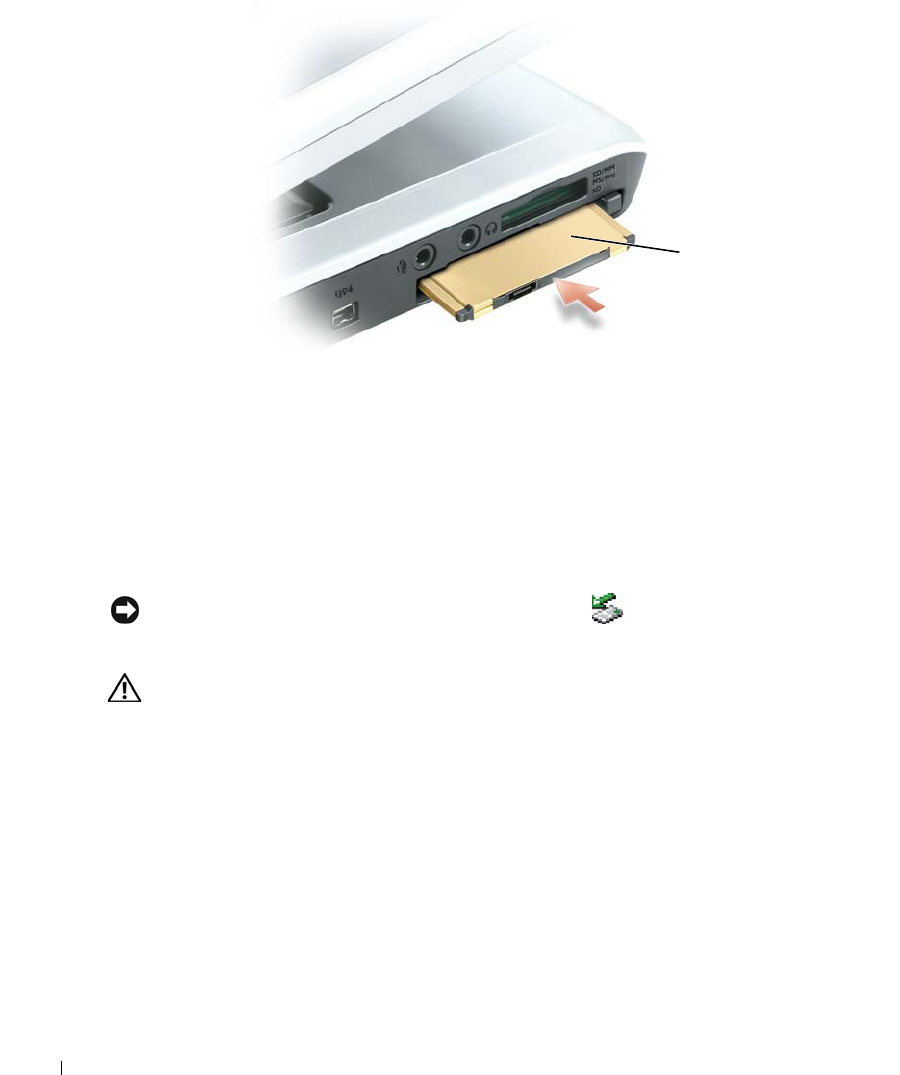
68 Using ExpressCards
www.dell.com | support.dell.com
The computer recognizes the ExpressCard and automatically loads the appropriate device
driver. If the configuration program tells you to load the manufacturer's drivers, use the floppy
disk or CD that came with the ExpressCard.
Removing an ExpressCard or Blank
NOTICE: Use the ExpressCard configuration utility (click the icon in the taskbar) to select a card
and stop it from functioning before you remove it from the computer. If you do not stop the card in the
configuration utility, you could lose data.
CAUTION: Before you begin any of the procedures in this section, follow the safety instructions in the
Product Information Guide
.
Press the latch and remove the card or blank. For some latches, you must press the latch twice:
once to pop the latch out, and then a second time to pop the card out.
Save a blank to use when no ExpressCard is installed in a slot. Blanks protect unused slots from
dust and other particles.
1ExpressCard
1
book.book Page 68 Wednesday, September 28, 2005 2:16 PM
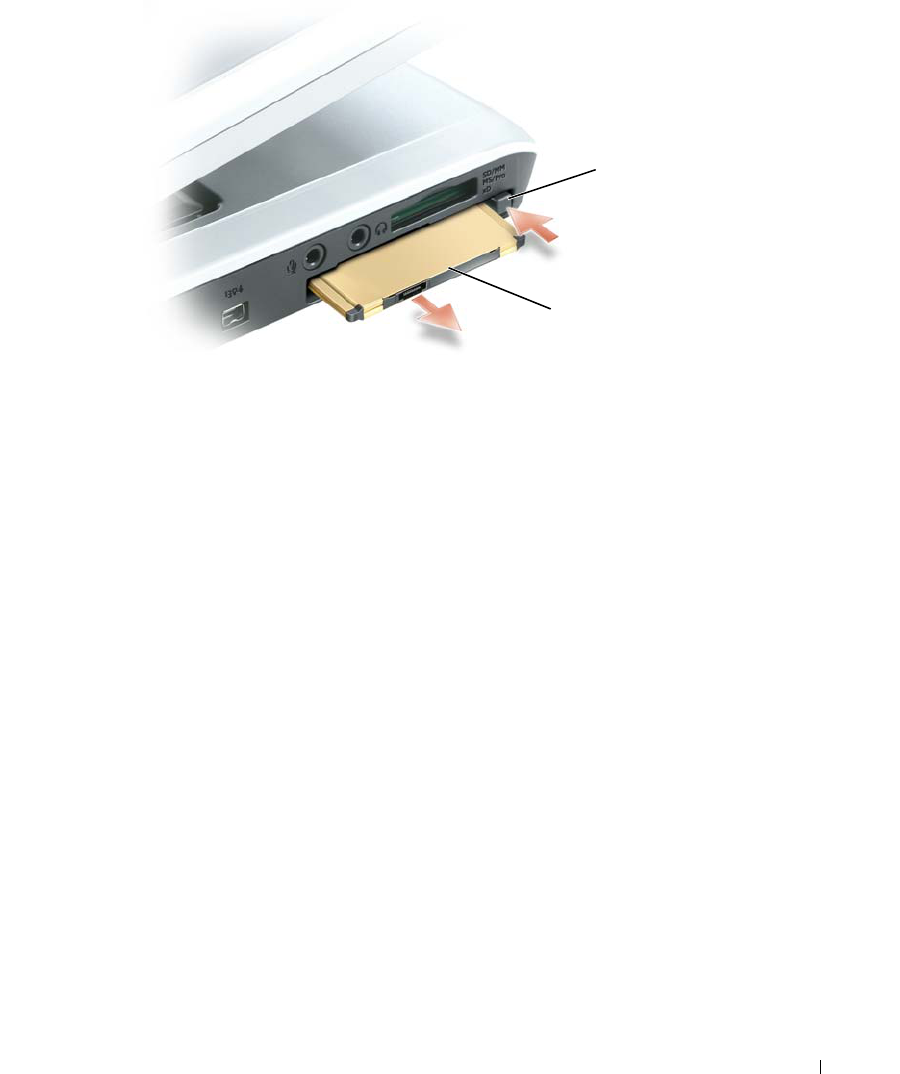
Using ExpressCards 69
1release button 2ExpressCard
1
2
book.book Page 69 Wednesday, September 28, 2005 2:16 PM

70 Using ExpressCards
www.dell.com | support.dell.com
book.book Page 70 Wednesday, September 28, 2005 2:16 PM

Using the 5-in-1 Media Memory Card Reader 71
9
Using the 5-in-1 Media Memory Card Reader
Media Memory Card Types
The 5-in-1 media memory card reader provides a fast and convenient way to view and share
digital photos, music, and videos stored on a memory card.
NOTE: A media memory card is not a bootable device.
The 5-in-1 media memory card reader reads the following media memory cards:
• Secure Digital (SD) card/SDIO
• MultiMediaCard (MMC)
•Memory Stick
•Memory Stick PRO
•xD-Picture Card
Media Memory Card Blanks
Your computer shipped with a plastic blank installed in the 5-in-1 media memory card slot.
Blanks protect unused slots from dust and other particles. Save the blank for use when no card is
installed in the slot; blanks from other computers may not fit your computer.
To remove the blank, see "Removing a Media Memory Card or Blank" on page 72.
Installing a Media Memory Card
You can install a media memory card in the computer while the computer is running. The
computer automatically detects the card.
Media memory cards are generally marked with a symbol (such as a triangle or an arrow) or a
label to indicate which end to insert into the slot. The cards are keyed to prevent incorrect
insertion. If card orientation is not clear, see the documentation that came with the card.
CAUTION: Before you begin any of the procedures in this section, follow the safety instructions in the
Product Information Guide
.
book.book Page 71 Wednesday, September 28, 2005 2:16 PM
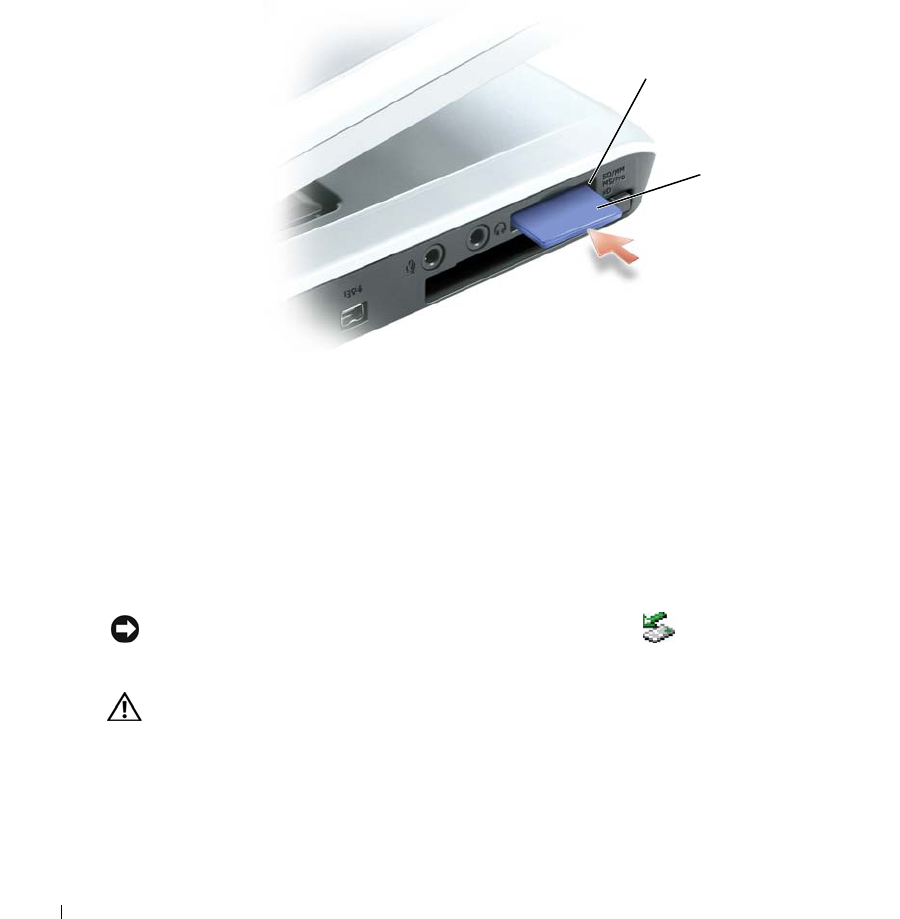
72 Using the 5-in-1 Media Memory Card Reader
www.dell.com | support.dell.com
To install a media memory card:
1
Hold the card with the top side of the card facing up.
2
Slide the card into the slot until the card is completely seated in its connector.
If you encounter too much resistance, do not force the card. Check the card orientation and
try again.
The computer recognizes the media memory card and automatically loads the appropriate
device driver. If the configuration program tells you to load the manufacturer's drivers, use the
CD that came with the media memory card, if applicable.
Removing a Media Memory Card or Blank
NOTICE: Use the media memory card configuration utility (click the icon in the taskbar) to select a
card and stop it from functioning before you remove it from the computer. If you do not stop the card in
the configuration utility, you could lose data.
CAUTION: Before you begin any of the procedures in this section, follow the safety instructions in the
Product Information Guide
.
Press the card in to release and remove the card or blank.
Save a blank to use when no media memory card is installed in the slot. Blanks protect unused
slots from dust and other particles.
15-in-1 media memory card
slot
2media memory card
1
2
book.book Page 72 Wednesday, September 28, 2005 2:16 PM
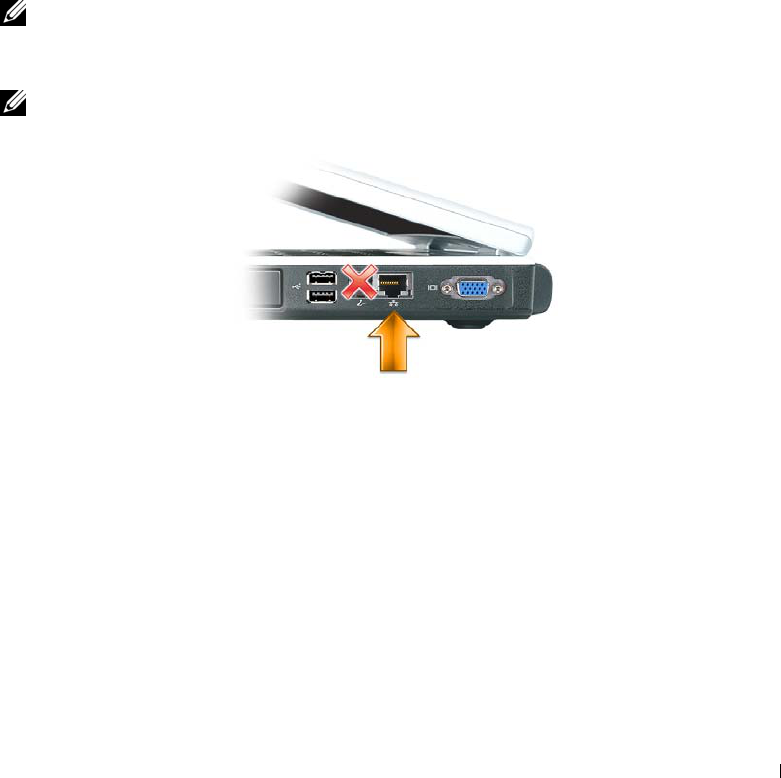
Setting Up a Home and Office Network 73
10
Setting Up a Home and Office Network
Connecting to a Network Adapter
Before you connect your computer to a network, the computer must have a network adapter
installed and a network cable connected to it.
To connect a network cable:
1
Connect the network cable to the network adapter connector on the back of your computer.
NOTE: Insert the cable until it clicks into place, and then gently pull it to ensure that it is secure.
2
Connect the other end of the network cable to a network connection device, such as a
network wall connector.
NOTE: Do not use a network cable with a telephone wall connector.
Network Setup Wizard
The Microsoft
®
Windows
®
XP operating system provides a Network Setup Wizard to guide you
through the process of sharing files, printers, or an Internet connection between computers in a
home or small office.
1
Click the
Start
button, point to
All Programs
→
Accessories
→
Communications
, and then
click
Network Setup Wizard
.
2
On the
Network Setup Wizard
welcome screen, click
Next
.
3
Click
Checklist for creating a network
.
book.book Page 73 Wednesday, September 28, 2005 2:16 PM
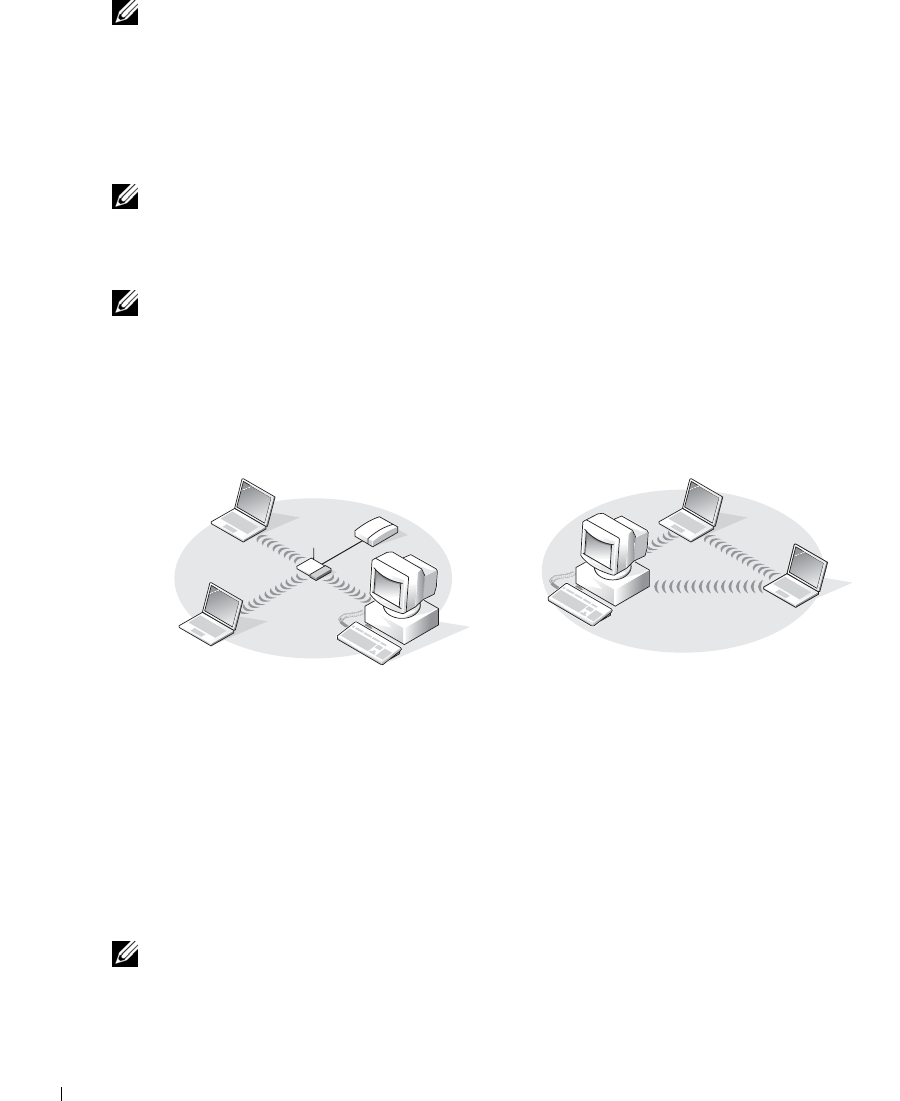
74 Setting Up a Home and Office Network
www.dell.com | support.dell.com
NOTE: Selecting the connection method This computer connects directly to the Internet enables the
integrated firewall provided with Windows XP Service Pack 1 (SP1) or later.
4
Complete the checklist and required preparations.
5
Return to the Network Setup Wizard and follow the instructions on the screen.
Connecting to a Wireless Local Area Network
NOTE: These networking instructions do not apply to internal cards with Bluetooth® wireless
technology or cellular products.
Determining Your Network Type
NOTE: Most wireless networks are of the infrastructure type.
Wireless networks fall into two categories—infrastructure networks and ad-hoc networks. An
infrastructure network uses routers or access points to connect several computers. An ad-hoc
network does not use routers or access points and consists of computers that broadcast to one
another. For additional assistance with setting up your wireless connection, go to
support.dell.com and search for the keyword wireless setup.
Connecting to a Wireless Network in Microsoft® Windows® XP
Your wireless network card requires specific software and drivers in order to connect to a
network. The software is already installed. If the software is removed or corrupted, follow the
instructions included in the user's guide for your wireless network card.
The user’s guide is located on the optional Drivers and Utilities CD in the "User’s Guides-
Network User’s Guides" category. The user’s guide is also available on the Dell Support website
at support.dell.com and may also be located on your computer desktop.
NOTE: The Drivers and Utilities CD is optional and may not be available for your computer or in certain
countries.
1infrastructure network 2ad-hoc network
12
book.book Page 74 Wednesday, September 28, 2005 2:16 PM
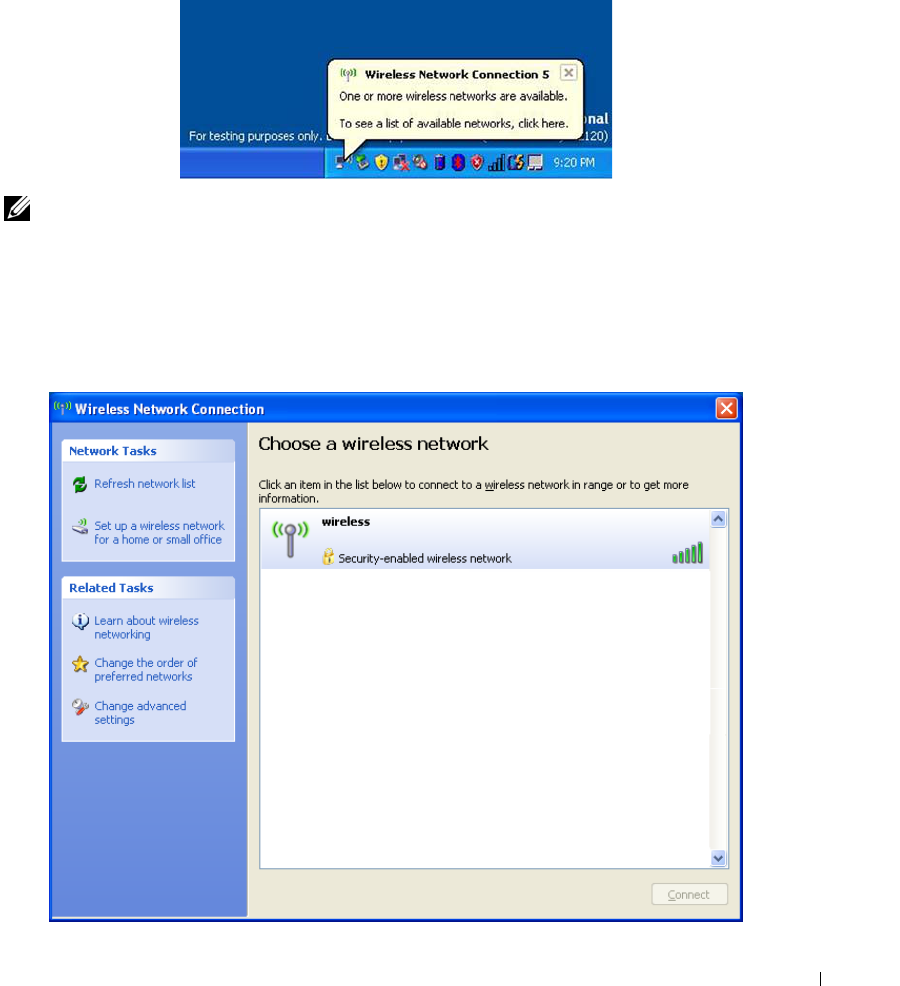
Setting Up a Home and Office Network 75
When you turn on your computer, a pop-up appears from the network icon in the notification
area (located in the lower-right corner of the Windows desktop) when a network, for which your
computer is not configured, is detected in the area.
NOTE: The following instructions apply if you use the Windows operating system to manage your
network devices. For information about other wireless configuration utilities, see your wireless network
documentation.
1
Click either the pop-up or the network icon to configure your computer for one of the
available wireless networks.
The
Wireless Network Connections
window lists the wireless networks available in your area.
book.book Page 75 Wednesday, September 28, 2005 2:16 PM
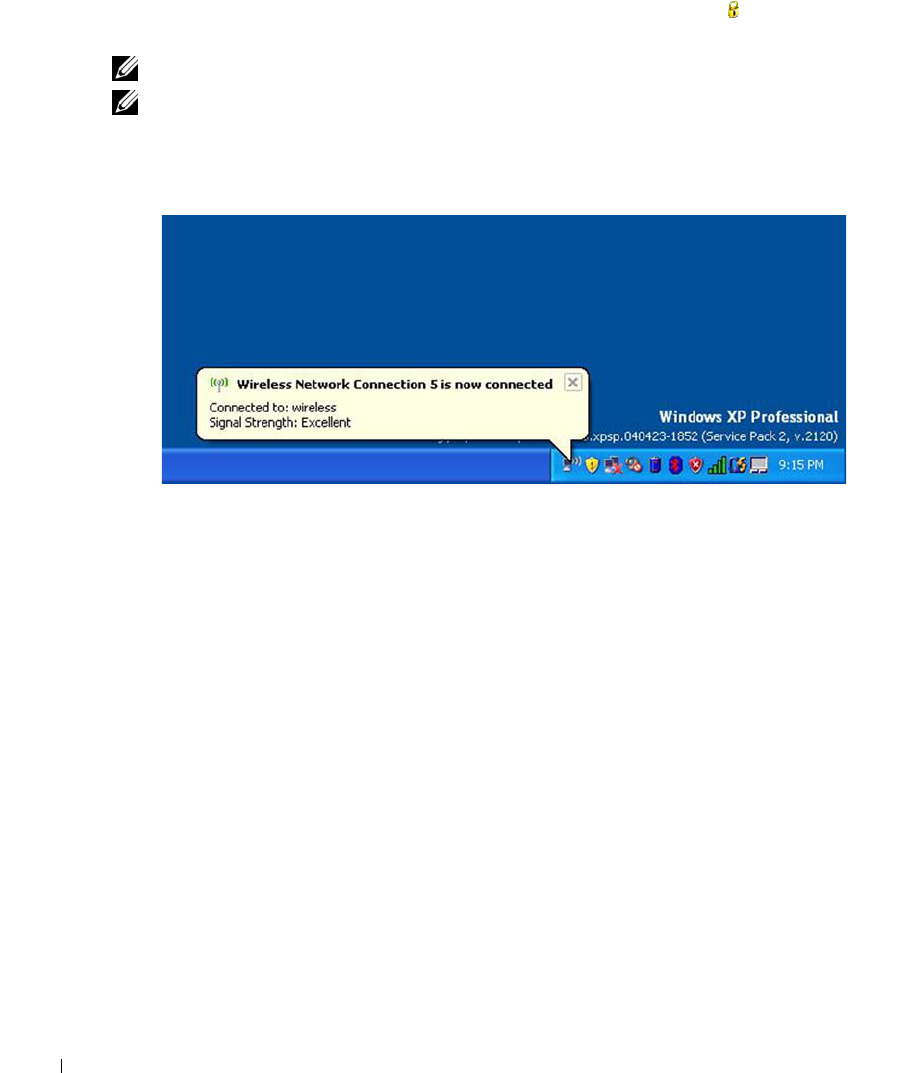
76 Setting Up a Home and Office Network
www.dell.com | support.dell.com
2
Click to select the network you want to configure, and then click
Connect
or double-click the
network name in the list. If you select a secure network (identified by a icon), you must
enter a password when prompted.
NOTE: Network security settings are unique to your network. Dell cannot provide this information.
NOTE: Your computer can take up to 1 minute to connect to a network.
After your computer is configured for the wireless network you selected, another pop-up
notifies you that your computer is connected to the network you selected.
Thereafter, whenever you log on to your computer in the area of the wireless network, the
same pop-up notifies you of the wireless network connection.
book.book Page 76 Wednesday, September 28, 2005 2:16 PM